#while identifying with a female character you need to change the narrative that's actually presented to you
Explore tagged Tumblr posts
Note
oh man i have a Lot of thoughts about the autopsy of jane doe, both positive and critical For Sure, i'd be SO excited to see your analysis of it! definitely keeping an eye out for that 👀
thanks! i'm working on something article-like to talk about the film and i don't know what i want to do with it yet lol but if i don't post it on here i'll definitely link it. it's mainly a discussion of gender in possession/occult films in the same way that carol clover describes in men, women, and chainsaws - that there are dual plot lines in occult films, usually gendered masculine and feminine respectively, where the "main" feminine plot (the actual possession) is actually a way to explore the "real" masculine plot (the emotional conflict of the "man in crisis" protagonist). typically the man in crisis is too masculine, or "closed" emotionally, where the woman is too "open," which is why she acts as the vehicle for the supernatural occurrence as well as the core emotions of the film. the man has to learn how to become more open (though if he becomes too open, like father karras in the exorcist, he has to die by the end - he has to find a happy medium, where he doesn't actually transgress gender expectations too much. clover calls this state the "new masculine," and we might apply the term "toxic masculinity" to the "closed" emotional state). part of the "opening up" feature of the story is that it allows men to be highly emotionally expressive in situations where they otherwise might not be allowed to, which is cathartic for the assumed primary audience of these films (young men). another feature of the genre is white science vs black magic (once you exhaust the scientific "rational" explanations, you have to accept that something magic is happening). the autopsy of jane doe does this even more than the films she discusses when she published the book in 1992 (the exorcist, poltergeist, christine, etc) because the supernaturally influenced young woman who becomes this kind of vehicle is more of an object than a character. she doesn't have a single line of dialogue or even blink for the entire runtime of the movie. the camerawork often pans to her as if to show her reactions to the events of the movie, which seems kind of pointless because it's the same reaction the whole time (none) but it allows the viewer to project anything they want onto her - from personal suffering to cunning and spite.
compare again to the exorcist: is the story actually about regan mcneil? no. but do we care about her? sure (clover says no, but i think we at least feel for her situation lol). and do we get an idea of what she's like as a person? yes. even though her pain and her body are used narratively as a framework for karras' emotional/religious crisis, we at least see her as a person. both she and her mother are expendable to the "real" plot but they're very active in their roles in the "main" plot - our "jane doe" isn't afforded even that level of agency or identity. so. is that inherently sexist? well, no - if there were other women in the film who were part of the "real" plot, i would say that the presence of women with agency and identity demonstrate enough regard for the personhood of women to make the gender of the subject of the autopsy irrelevant. but there are none. of the three important women in the film, we have 1) an almost corpse, 2) an absent (dead) mother, and 3) a one dimensional girlfriend who is killed off for a man's character development/cathartic expression of emotions. all three are just platforms for the men in crisis of this narrative.
and, to my surprise, much of the reception to the film is to embrace it as a feminist story because the witch is misconstrued as a badass, powerful, Strong Female Character girl boss type for getting revenge on the men who wronged her, with absolutely no consideration given to what the movie actually ends up saying about women. and the director has said that he embraces this interpretation, but never intended it. so like. of course you're going to embrace the interpretation that gives you critical acclaim and the moral high ground. but it's so fucking clear that it was never his intention to say anything about feminism, or women in general, or gender at all. so i find it very frustrating that people read the film that way because it's just. objectively wrong.
there's also things i want to say about this idea that clover talks about in a different chapter of the book when she discusses the country/city divide in a lot of horror (especially rape-revenge films) in which the writer intends the audience to identify with the city characters and be against the country characters (think of, like, house of 1000 corpses - there's pretty explicit socioeconomic regional tension between the evil country residents and the travelers from the city) but first, they have to address the real harm that the City (as a whole) has inflicted upon the Country (usually in the forms of environmental and economic destruction) so in order to justify the antagonization the country people are characterized by, their "retaliation" for these wrongs has to be so extreme and misdirected that we identify with the city people by default (if country men feel victimized by the City and react by attacking a city woman who isn't complicit in the crimes of the City in any of the violent, heinous ways horror movies employ, of course we won't sympathize with them). why am i bringing this up? well, clover says this idea is actually borrowed from the western genre, where native americans are the Villains even as white settlers commit genocide - so they characterize them as extremely savage and violent in order to justify violence against them (in fiction and in real life). the idea is to address the suffering of the Other and delegitimize it through extreme negative characterization (often, with both the people from the country and native americans, through negative stereotyping as well as their actions). so i think that shows how this idea is transferred between different genres and whatever group of people the writers want the viewers to be against, and in this movie it’s happening on the axis of gender instead of race, region, or class. obviously the victims of the salem witch trials suffered extreme injustice and physical violence (especially in the film as victim of the ritual the body clearly underwent) BUT by retaliating for the wrongs done to her, apparently (according to the main characters) at random, she's characterized as monstrous and dangerous and spiteful. her revenge is unjustified because it’s not targeted at the people who actually committed violence against her. they say that the ritual created the very thing it was trying to destroy - i.e. an evil witch. she becomes the thing we're supposed to be afraid of, not someone we’re supposed to sympathize with. she’s othered by this framework, not supported by it, so even if she’s afforded some power through her posthumous magical abilities, we the viewer are not supposed to root for her. if the viewer does sympathize with her, it’s in spite of the writing, not because of it. the main characters who we are intended to identify with feel only shallow sympathy for her, if any - even when they realize they’ve been cutting open a living person, they express shock and revulsion, but not regret. in fact, they go back and scalp her and take out her brain. after realizing that she’s alive! we’re intended to see this as an acceptable retaliation against the witch, not an act of extreme cruelty or at the very least a stupid idea lol.
(also - i hate how much of a buzzword salem is in movies like this lol, nothing about her injuries or the story they “read” on her is even remotely similar to what happened in salem, except for the time period. i know they don’t explicitly say oh yeah, she was definitely from salem, but her injuries really aren’t characteristic of american executions of witches at all so i wish they hadn’t muddied the water by trying to point to an actual historical event. especially since i think the connotation of “witch” and the victims of witch trials has taken on a modern projection of feminism that doesn’t really make sense under any scrutiny. anyway)
not to mention the ending: what was the writer intending the audience to get from the ending? that the cycle of violence continues, and the witch’s revenge will move on and repeat the same violence in the next place, wherever she ends up. we’re supposed to feel bad for whoever her next victims will be. but what about her? i think the movie figures her maybe as triumphant, but she’s going to keep being passed around from morgue to morgue, and she’s going to be vivisected again and again, with no way to communicate her pain or her story. the framework of the story doesn’t allow for this ending to be tragic for her, though - clearly the tragedy lies with the father and son, finally having opened up to one another, unfortunately too late, and dying early, unjust deaths at the hands of this unknowable malignant entity. it doesn’t do justice to her (or the girlfriend, who seems to be nothing but collateral damage in all of this - in the ending sequence, when the police finds the carnage, it only shows them finding the bodies of the men. the girlfriend is as irrelevant to the conclusion as she is to the rest of the plot).
but does this mean the autopsy of jane doe is a “bad” movie? i guess it depends on your perspective. ultimately, it’s one of those questions that i find myself asking when faced with certain kinds of stories that inevitably crop up often in our media: how much can we excuse a story for upholding regressive social norms (even unintentionally) before we have to discount the whole work? i don’t think the autopsy of jane doe warrants complete rejection for being “problematic” but i think the critical acclaim based on the idea that it’s a feminist film should be rejected. i still consider it a very interesting concept with strong acting and a lot of visual appeal, and it’s a very good piece of atmospheric horror. it’s does get a bit boring at certain points, but the core of the film is solid. it’s also not trying to be sexist, arguably it’s not overtly sexist at all, it’s just very very androcentric at the expense of its female characters, and i’m genuinely shocked that anyone would call it feminist. so sure, let’s not throw the baby out with the bath water, but let’s also be critical about how it’s using women as the stage for men’s emotional conflict
also re: my description of this little project as “a film isn’t feminist just because there’s a woman’s name in the title” - i actually don’t want to skim over the fact that “jane doe” isn’t a real name. of the three women in the film, only one has a real name; the other two are referred to by names given to them by men. i’ll conclude on this note because i want to emphasize the lack of even very basic ways of recognizing individual identity afforded to women in this film. so yeah! the end! thanks for your consideration if you read this far!
#the autopsy of jane doe#men women and chainsaws#horror#also to be clear i'm not saying that the exorcist is somehow more feminist because. it's not. i'm just using it as a frame of reference#you'd think a film from 2016 would escape the ways gender is constructed in one from 1973 but that's not really the case#i actually rewatched the end of the movie to make sure that what i said about the girlfriend's body not being found at the end was accurate#and yeah! it is! the intended audience-identified character shifts to the sheriff who - that's right! - is also a man#the camerawork is: shot of the dead son / shot of the sheriff looking sad / shot of the dead father / shot of the sheriff looking sad /#shot of jane doe / shot of the sheriff looking upset angry and suspicious#which is how we're supposed to feel about the conclusion for each character#the girlfriend is notably absent in this sequence#anyway! this is less about me condemning this movie as sexist and more about looking at how women in occult horror#continue to be relegated to secondary plot lines at best or to set dressing for the primary plot line at worst#and what that says about identification of viewers with certain characters and why writers have written the story that way#i think the reception of the film as Feminist might actually point to a shift in identification - but to still be able to enjoy the movie#while identifying with a female character you need to change the narrative that's actually presented to you#hence the rampant impulse to misinterpret the intention of the filmmakers#we do want it to be feminist! the audience doesn't identify with the 'default' anymore automatically#i think that's actually a pretty positive development at least in viewership - if only filmmakers would catch up lol#oh and i only very briefly touched on this here but the white science vs black magic theme is pretty clearly reflected in this film also
84 notes
·
View notes
Note
Do you think that if Zutara was canon, the people who justify Kataang by saying that it's canon would've shipped Zutara instead?
Some of them would. Really, it depends on a lot of factors, like why people ship things in the first place. Some people are only interested in canon pairings, and some people who ship KA definitely are those kinds of people. But it also depends HOW it's presented if zutara were canon.
What I mean is, yes, it's true that some people ship things based on whether they are canon, but it's also true that some people who ship KA do so because the narrative leads us to hope Aang will get with Katara in the end, because we've been watching him crush on her from the first episode. The show wants us to identify with Aang's crush, which of course is one of the big criticisms of people who don't feel like KA prioritizes Katara's feelings enough. But if you're one of the viewers who watched the show and identified with Aang the way the show leads you to, then you ship KA.
Let's say zutara does become canon. What does that mean? Does it mean the romance is instead written from Zuko's perspective? If that were the case, the people who ship KA because they identify with Aang's crush would likely also ship zutara in this theoretical scenario. However, a lot would have to be different about the show for us to conceive of it this way. Zuko isn't positioned as the hero of the story, especially not at the beginning. He is A hero and a point of audience identification, but the show has to work to get him there because they position him as a villain at first. So if the narrative were to present zutara as the canon romance with the narrative being about Zuko's crush on Katara, a lot would have to change.
That's why a lot of people who identify with Katara ship zutara, because Zuko's relationship with the other characters isn't about Zuko's feelings, and when it is, it's about how Zuko has to change to meet the needs of the other characters, not the other way around.
The other theoretical canon zutara scenario is the one I see most zutara stans advocating for, the one where not much changes in the main narrative of the show, but have Aang's crush on Katara remain unreciprocated while growing Katara and Zuko's relationship into something romantic. This sort of narrative can be done, and is a more popular way of writing young adult media nowadays than it was twenty or so years ago, because conversations about what girls want and consent are more prevalent than they used to be.
Of course, even in narratives that do prioritize a female character's feelings, you still get people who will only identify with a male character or prioritize his feelings, because even though the Nice Guy narrative has gotten a lot of criticism in recent years, it still exists, and has existed for a long time.
I also tend to the think that no matter how well zutara was written and how it prioritized Katara's feelings, you'd still have people screaming about how Zuko is a bad boy who is corrupting Katara and leading her astray from wholesome good guy Aang, because people already say that and Katara and Zuko only hug platonically onscreen. As I said, the nice guy narrative is so prevalent in our society that people imagine that it's there even when it isn't. Which is actually really quite meta, because Aang did the same thing with Katara in "Ember Island Players" when he yelled at her for the imagined actions of her actress and how she didn't magically end up in a relationship with him despite him never once asking her out.
But, again, people ship things for all sorts of reasons and I'm certainly not saying all people who ship KA do so because it's canon or for bad reasons, just as not everyone who ships zutara would have wanted it to be canon or cares whether it is. Some people ship characters who never interact in canon and that's perfectly valid, too. That's the main problem with the "it's canon" justification, because at the end of the day, people ship things for all sorts of reasons, and a lot of people have really good and creative reasons for why they ship stuff. In my view, whether something is canon or not is one of the least interesting reasons to ship something, because most of my participation in fandom is about whether or not there's a story to explore, and noncanon ships usually have the most untapped potential. But that's just me.
93 notes
·
View notes
Text
The Green Knight (2021)
(CONTAINS SPOILERS)
The Green Knight (2021), with its excellent cast and feast of visual storytelling, does cut a pretty trailer, but it’s hardly the adaptation we’ve all waited nearly 2 years to see. Rather on the slow side, there is plenty of breathing room (often to excess), but often feels wanting. The performances are well-played, albeit terribly subdued, which create interludes that feel tedious. Dev Patel has proven himself time and again that he has the capacity to play a nuanced lead, and he does well here, but it is the side characters that break the monotony and steal the show, most notably Joel Edgerton (Lord), Erin Kellyman (Winifred), and Barry Keoghan (Scavenger).
David Lowery’s “adaptation” explores the journey of an untested and somewhat undeserving not-quite-Sir Gawain, a far-cry from our Hero in the text, more akin to Prince Hal. This change adds elements to the character with which an audience might more easily identify, and should make this a coming-of-age tale, as well as a moral one; though, this film fails as both.
As a coming-of-age tale, Gawain never quite gets there, and it almost doesn’t matter if he does, because it's not really his tale at all. Nor is this film about morality, not even as a cautionary tale. Perhaps it's more accurate to call it an instance of ‘careful what you wish for’. Gawain doesn’t seem to know what he wants. Does he really want to be a Knight? Is this about living an honest life or living up to familial expectations, particularly your mother's? Hard to say, as many of the female characters, including Gawain’s mother (Morgause and Morgan Le Fay made one), are treated as mystery elements themselves. It’s also not clear just how far her control extends, if it has any limitations. Is there anything in this world that is true?
Perhaps we'll never know his mother's true intentions; it clearly wasn't for her son to be his own person and make his own decisions. A man simply doesn’t become a Legend without his mother’s entire fabrication of the quest, it would seem. Does Gawain feel so out of place in his own story because it’s already set out for him? Was Morgan Le Fay simply Lowery’s segue for the concept of Legend as a set path for Gawain to follow? But as such, Gawain’s tale of morality isn’t what it seems, as he doesn’t even have the illusion of choice. Or was it all just a journey back to nature, back to green? Lowery never lets us forget just what color matters most here. There’s even a fun monologue about it! Even the design of the Green Knight is just a little too on the nose; his appearance essentially being that of an ent.
About 2/3 of the way through, The Green Knight actually shows a hint of promise, but it is short-lived. In case you haven’t already lost interest with the lengthy side quests; everything turns sour at the arrival of Lord and Lady Bertilak’s castle (simply titled Lord and Lady), and what should be the bulk of our story, the “exchange of gifts” and Gawain’s true test of morality. The “exchange of gifts” is glossed over for a taste of something completely different, as it takes major liberties with not only a core part of our tale, but arguably what’s most memorable about the original. It becomes Lowery’s convoluted vision of a different sort entirely, one where Gawain seemingly refuses to take part in his own story. While possibly an interesting take in itself, it does a disservice to the text, and accomplishes nothing other than an attempt to be shocking.
There’s something richer in the “exchange of gifts” simply not explored in Lowery’s version, or the compulsive need to “subvert”, and the film is poorer for it. How can you even subvert something which you refuse to touch upon? It’s also extremely odd and honestly baffling, that in this day and age, homosexual themes and undertones would be downplayed or outright rejected (as they are here), rather than embraced and explored. Altogether, this omission seems a poor choice and a clear indication that Lowery holds little to no affection for the original text. Disregarding the “exchange of gifts”, the journey becomes something vain and hollow; perhaps intentionally, but doesn't serve anyone, least of all the story.
Following the tale’s example, the girdle (sans the accompanying scar) is the all-encompassing symbol for Gawain’s shame, but Lowery takes it a step further, in which he is so seduced by its promise of protection that he literally soils it with his lust. But this scene is so abrupt at the all too brief “exchange of gifts” (in a film that stretches everything to excess) that it seems to lack consideration and its only purpose is to disturb. The girdle furthermore becomes a symbol of his unearned and unholy life (which we’re shown), were he to continue to fail to accept his fate and his test, although this too seems superfluous. What’s interesting here is that in either scenario, Gawain remains undeserving. He is not especially virtuous, he’s not even decent from what we can see, and has failed in almost every chivalric aspect; after all, he is “no knight”. Even so, in the original, even the Green Knight can’t begrudge his lack of fidelity in this one aspect; “because you wanted to live, so I blame you the less”.
A message of The Green Knight seems to be acting out of selflessness as the only indicator of a truly good deed, with no expectation of reward. This is evident in the dismissal of the “exchange of gifts” and Winifred’s admonishment, "Why would you ever ask me that?", but this message is so muddled within the world of the film, that it’s somehow also completely out of place. After all, Gawain is rewarded in a way, with several of his trappings, which are returned to him after being stolen. Speaking of rewards for good deeds, religious themes are also notably lacking, favoring the pagan angle (as expected of A24), though which is never expounded upon. There is the decision to keep some not-so-subtle imagery of crippled Christianity; i.e Gawain’s shield (with Mary’s visage on the inside and a small pentangle on the exterior) and a cross at the Green Chapel.
Lowery gets too hung up on a confused mix of vague and painfully obvious ideas of symbolism and makes huge, unwarranted leaps. His work here reeks of self-indulgence, to the point of parody. It’s also simply never clear what anyone’s intentions are, his least of all. His ideas are so flighty and changeable that contradictions abound in the finished product (It’s clear why he needed all that extra time to re-cut). The whole thing is so nebulous that it may fool some into thinking it’s beyond their grasp, but it just reads as pretentious. The thing is, The Green Knight tries to be too many things at once, and in doing so, fails at all of them. Lowery lacks the conviction to support anything he presents and has no sense of narrative structure. Simply put, this film lacked proper direction and would have greatly benefited from fresh eyes on the script.
The Green Knight may question 'What is Honor and if it does exist, what is it worth? For even if there comes a time to prove yourself for Honor’s sake, what is it all for? “Is this all there is?”’, but Lowery drops the concept of Honor as soon as he picks it up and chooses to explore Legacy and Legend, and while it leads us on an interesting journey of interpretation, it’s very heavy-handed. It’s also difficult to answer any of these questions because Gawain is simply not worthy of anything. It’s not just that he is imperfect; he is not good and never acts out of selflessness or for the actual sake of Honor. He doesn’t know the meaning of the word. The original text asks us to stay true, true to our word and our values, in uncertainty and despite our fears (as a Good Knight should, and which Gawain ultimately is.) Lowery, on the other hand, begs us to forget the narrative, because he doesn’t know how to do it, and the search for meaning, because there is none. I’m not even sure he knows what he’s made.
Overall, though heavily burdened by its sluggish pace and lack of structural integrity, The Green Knight, at least on the surface, appears to be a somewhat earnest attempt at exploration within the fantasy/horror genre, asking a lot more questions than it answers. But while its visuals may dazzle, it’s a cold and unfeeling thing, devoid of all charm of the original tale, and can hardly be called an adaptation for many of its choices.
Source: https://letterboxd.com/avega007/film/the-green-knight/
(I wasn’t expecting to go off when I just got a letterboxd, but this film left me heated.)
#the green knight#sir gawain and the green knight#david lowery#dev patel#I really wanted to like it#but it disappointed me#spoilers
15 notes
·
View notes
Text
Red Wings of Temperance
A Possible Influence Behind the Color of Hawks’ Wings
A deck of tarot cards is made up of 78 cards, and the first twenty two are known as the Major Arcana. They were created in the 14th or 15th century but were not used for divination purposes until the 18th century. Tarot card readings are not meant to predict the future but to offer spiritual guidance.
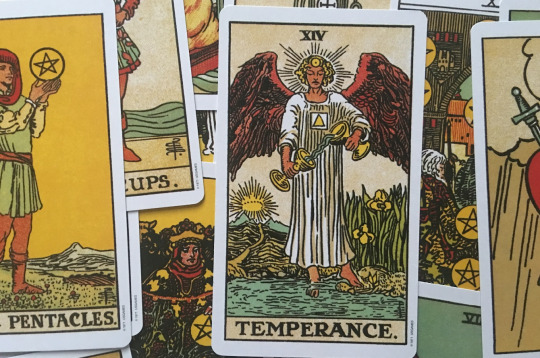
The image above (from Oracloo) depicts the 14th Major Arcana card in the tarot deck which is known as: XIV Temperance.
Like me, I’m sure that your mind jumped to a certain pro hero as soon as you saw the figure’s red wings.
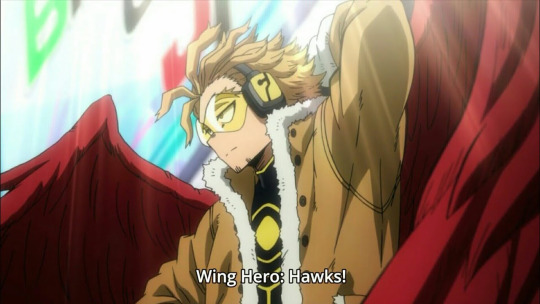
What might Temperance have to do with Hawks? Let’s first look at a couple definitions of the word first. According to Merriam-Webster:
Temperance
1. moderation in action, thought, or feeling
2. habitual moderation in the indulgence of the appetites or passions
If Temperance is drawn, it means:
Balance, patience, and moderation in life.
To think before we act. To look at both sides of an issue, to walk in another’s shoes or their path before we pass judgement. To be compassionate, considerate and fair in our dealings with others (bluestartarot).
That you have a clear, long-term vision of what you want to achieve. You are not rushing things along; instead, you are taking your time to ensuer that you do the best job you can. You know you need a moderate, guided appraoch to reach your goals (biddytarot).
Other Red-Winged Figures
Before we begin I’m going to point out that there are a couple other Red-Winged figures amongst the Major Arcana.
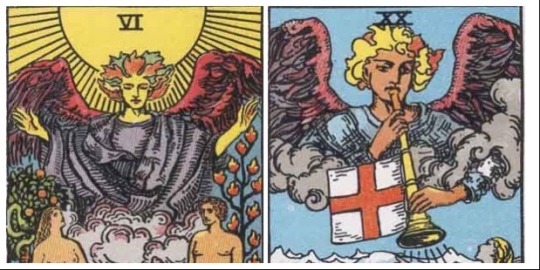
I’m not aware if nudity in art is allowed on Tumblr so just to be safe, I cut the bottom half of both these cards because they depict nude individuals.
The tarot card on the right is VI The Lovers and XX Judgement. Out of the two, I think you could perhaps make some connections with Judgement and Hawks but I think that Temperance works the best.
Symbols of the 14th Arcana
There are quite a few symbols on XIV Temperance, but I’m going to focus on a select few. Interpretations may differ based on the source but I tried to stick with those that were repeated throughout the different websites I read through.
The most important part of this card is the act of pouring water from one cup to another, signifying a balance of duality and a mixture of two separate objects. This is where the card gets its name, the process is called “tempering” which is a slow process to eventually find a perfect middle ground (wemystic).
Other dualities that is represented on this card can be: male/female, spiritual/physical, emotion/logic, conscious/subconscious and subconscious/superconscious (we mystic).
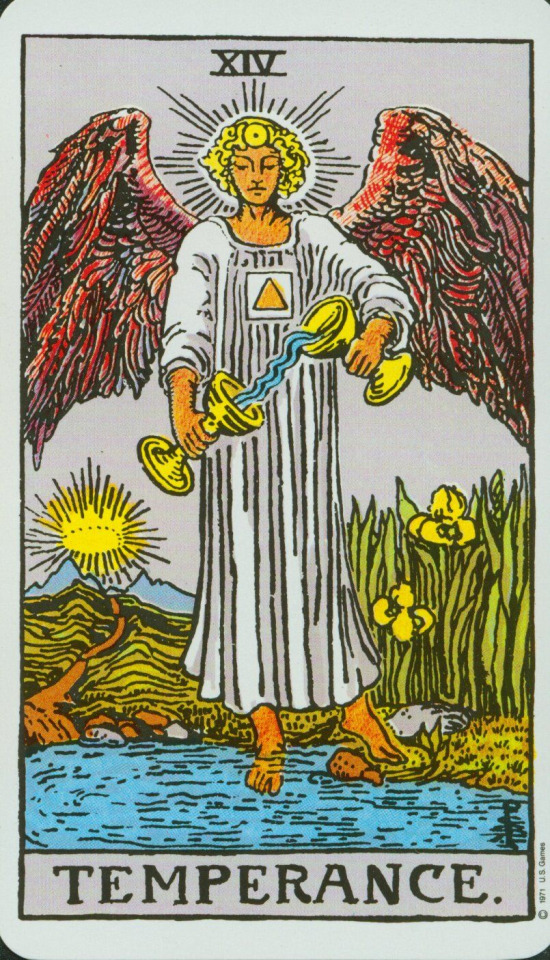
Temperance revolves around supreme balance. One foot is on land which represents the Earthly, material world and the other is in water, which represents the emotional, subconscious world.
The winding path leading to the mountains represents the journey through life with its twists and turns. The sun, appearing as a glowing light is a symbol of staying true to one’s life purpose and meaning (biddytarot).
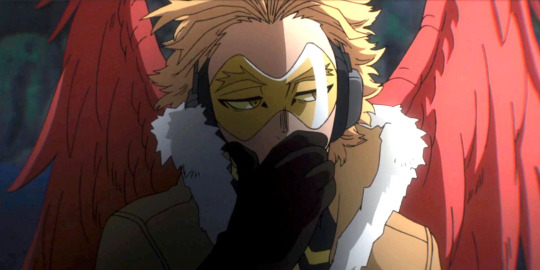
Fire/Red wings: Physical passion, anger. Muscles and strength necessary to maintain composure and reach a higher being state.
Blue water: Emotions, peace, calm. Groundness and refreshment.
White gown: Pure thought.
Yellow Iris: Communication, thoughts, learning, feminine/masculine.
Temperance’s wings are either referred to as “fire wings” or “red wings.” If we want to make connections to we can argue that his Fierce Wings Quirk is the source of his physical strength, even though he displays some insecurity about his back not being “reassuring” enough for others to depend on.
Other than his red wings, I don’t think I’m confident enough to draw a clear connection between his appearance and the other prominent colors that appear on Temperance. Hawks’ visor was blue before the anime chose yellow, and he does have the yellow color palette going on.
However, the meanings of the colors do line up with Hawks’ character. He is a character who is always trying to be calm and collected no matter the situation. Hawks is a character who is constantly seeking, taking in, gathering, and analyzing information. According to the fandom website, Hawks’ surname translates as: “hawk” (taka 鷹) + “see, visible, idea” (mi 見 )
While his first name translates as: “disclose, open, say” (kei 啓) + “enlightenment, understanding” (go 悟).
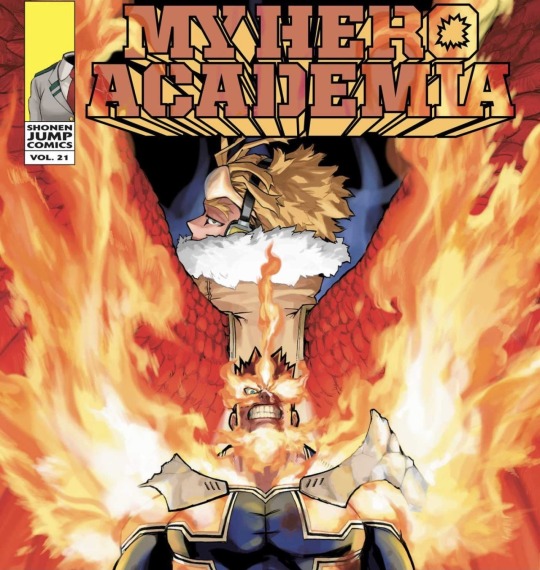
Sun: Also appearing as the angel’s third eye, it represents the merging of personal aims with the universe’s plans for the individual.
So similar to many others, I like to see Endeavor as the sun to Hawks’ Icarus (side note: I also like to see Dabi as Apollo in the Icarus theme).
The bit about the eye is interesting as well: I believe that eyes play an important role in the story telling with Hawks, Endeavor and other characters. There are interesting similarities between the two characters and the Egyptian Gods Ra and Horus (@/bokunowtv also pointed out some interesting details as well).
Recently, it also seems like Hawks’ storyline will be intertwining with Endeavor’s. Hawks has expressed verbally in Chapter 299: “Starting with my origin, so to speak... Endeavor’s in trouble.” While they did team up professionally as heroes in the past, it seems that Hawks intentions this time will be personal. We have yet to see what he is planning to do and how things might pan out, however this path will probably lead him to Touya.
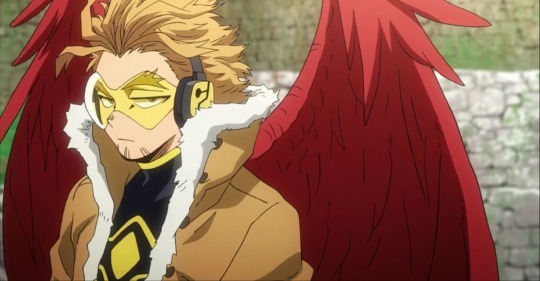
Triangle: Representative of the fire element and holy trinity.
Although Hawks does not wear a triangle or square on his chest like the angel, it is still interesting to note that he wears the Hero Public Safety Commission’s diamond symbol in about the same place. Again, there is the mention of fire again.
The Angel
Because Temperance has to do with balance and duality, the angel on the card is both masculine and feminine.
Whether they are just an unnamed angel or a Biblical angel depends on the source you are looking at. However when it comes to identifying them, while one states that it is the Archangel Gabriel, the sources I looked at overwhelmingly pointed towards the Archangel Michael.
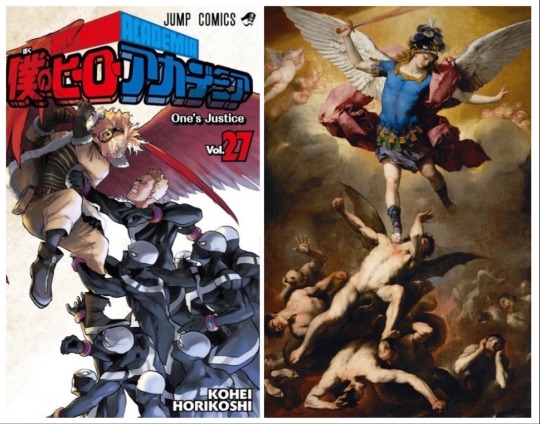
This is very, very interesting considering that the Archangel Michael is the angel who is in all the paintings that people were comparing the cover of Volume 27 with, specifically the painting above: “The Fall of the Rebel Angels” by Luca Giordano.
My analysis first post on Tumblr had to do with pointing out similarities between the Archangel Michael and Hawks, and what that could mean. And my most recent post revisits the possible angel narrative which may be present in Hawks’ story, and how he is referred to as a “fallen angel.”
It’s exciting to see the Archangel Michael pop up again. Michael was also God’s angel of destruction and on XIV Temperance we see him tempering or blending his passionate anger with consicious thought to blend his fiery nature with his super-consciousness with calm (blustartarot).
Temperance Reversed
When Tarot cards are reversed, their definitions are flipped over.
When XIV Temperance meets XV The Devil we see imbalance, disharmony, indifference and lack of empathy. When we preactice excess in our lives without moderation and balance whether it be food, alcohol, drugs, and relationships, we lose ourselves in addiction and bondage (bluestartarot).
May call for a period of self-evaluation in which you can re-examine your life priorities. Self-healing: by creating more balance and moderation in your life (biddytarot).
We’ve seen Hawks indulge in something or trip up a couple of times. In Chapter 186, Hawks asks if he can have Endeavor’s leftover food and Endeavor calls him a glutton. Additionally, @/scarletrain1724 has done some analysis on how Hawks is a character who is often seen around or consuming food.

And in Chapter 265, Hawks takes Jin’s life. As Dabi states below, “sentiments” tripped him up. Hawks displays a lack of empathy here. He believes that he feels sorry for Jin and wants to help him, but Hawks is actually unable to understand him properly. I would also identify this action as one of Hawks’ narrative Icarus falls.
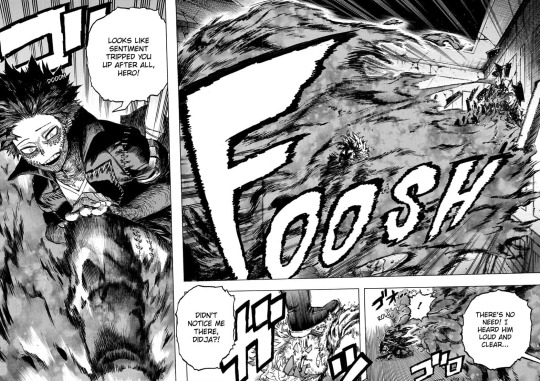
The Moral of Icarus’ Fall
This all ties in nicely as we see Hawks’ character following an Icarus narrative. There are a handful of “morals” that we the reader are supposed to gain from the Fall of Icarus but I’ll pull an excerpt from the part I’d like to focus on.
Before taking flight, Daedalus warned his son:
“Take care to fly halfway between the sun and the sea. If you fly too high, the sun’s heat will melt the wax that bids your wings. If you fly too low, the sea’s mist will dampen the feathers that give you life. Instead, aim for the middle course and avoid extremes.” (The Fall of Icarus - adapted from Metamorphoses by Ovid)
As we all know, Icarus does not heed his father’s warning, whether it be cause he purposely ignored him or forgot and flies up towards the sun. The sun’s heat melts the wax and loosens the feathers on his manmade wings, and he plummets in to the ocean below, drowning.
Avoid extremes, fly in the middle and seek temperance.
The card that comes before Temperance is XIII Death.
In death we go through transition, a rebirth, changes and with these we come to XIV Temperance for the need to take the time to pause and think. To integrate and blend what we have learned on our journey (bluestartarot).
So the question to ask is, has Hawks learned anything from his actions or will his story end with him drowning in the ocean?
To those who were able to make it through this post, thank you! I know that it was really long but I didn’t want to divide it into more than one part. I really appreciate your time and attention! :)
#visual#hawks#takami keigo#bnha analysis#mha analysis#mythological influences#religious influences#bnha#mha#bnha meta#mha meta#luna writes#my post
33 notes
·
View notes
Text
CW for discussion of suicide
- She's the crazy ex-girlfriend - What? No, I'm not. - She's the crazy ex-girlfriend - That's a sexist term! - She's the crazy ex-girlfriend - Can you guys stop singing for just a second? - She's so broken insiiiiiide! - The situation's a lot more nuanced than that!
There’s the essay! You get it now. JK.
Crazy Ex-Girlfriend is the culmination of Rachel Bloom’s YouTube channel (and the song “Fuck Me, Ray Bradbury” in particular where she combined her lifelong obsession with musical theatre and sketch comedy and Aline Brosh McKenna stumbling onto Bloom’s channel one night while having an idea for a television show that subverted the tropes in scripts she’d been writing like The Devil Wears Prada and 27 Dresses.
The show begins with a flashback to teenage Rebecca Bunch (played by Bloom) at summer camp performing in South Pacific. She leaves summer camp gushing about the performance, holding hands with the guy she spent all summer with, Josh Chan. He says it was fun for the time, but it’s time to get back to real life. We flash forward to the present in New York, Rebecca’s world muted in greys and blues with clothing as conservative as her hair.
She’s become a top tier lawyer, a career that she doesn’t enjoy but was pushed into by her overprotective, controlling mother. She’s just found out she’s being promoted to junior partner, and that’s just objectively, on paper fantastic, right?! ...So why isn’t she happy? She goes out onto the streets in the midst of a panic attack, spilling her pills all over the ground, and suddenly sees an ad for butter asking, “When was the last time you were truly happy?” A literal arrow and beam of sunlight then point to none other than Josh Chan. She strikes up a conversation with him where he tells her he’s been trying to make it in New York but doesn’t like it, so he’s moving back to his hometown, West Covina, California, where everyone is just...happy.
The word echoes in her mind, and she absorbs it like a pill. She decides to break free of the hold others have had over her life and turns down the promotion of her mother’s dreams. I didn’t realize the show was a musical when I started it, and it’s at this point that Rebecca is breaking out into its first song, “West Covina”. It’s a parody of the extravagant, classic Broadway numbers filled with a children’s marching band whose funding gets cut, locals joining Rebecca in synchronized song and dance, and finishing with her being lifted into the sky while sitting on a giant pretzel. This was the moment I realized there was something special here.
With this introduction, the stage has been set for the premise of the show. Each season was planned with an overall theme. Season one is all about denial, season two is about being obsessed with love and losing yourself in it, season three is about the spiral and hitting rock bottom, and season four is about renewal and starting from scratch. You can see this from how the theme songs change every year, each being the musical thesis for that season.
We start the show with a bunch of cliché characters: the crazy ex-girlfriend; her quirky sidekick; the hot love interest; his bitchy girlfriend; and his sarcastic best friend who’s clearly a much better match for the heroine. The magic of Crazy Ex-Girlfriend is that no one in West Covina is the sum of their tropes. As Rachel says herself, “People aren’t badly written, people are made of specificities.”
The show is revolutionary for the authenticity with which it explores various topics but for the sake of this piece, we’ll discuss mental health, gender, Jewish identity, and sexuality. All topics that Bloom has dug into in her previous works but none better than here.
Simply from the title, many may be put off, but this is a story that has always been about deconstructing stereotypes. Rather than being called The Crazy Ex-Girlfriend, where the story would be from an outsider’s perspective, this story is from that woman’s point of view because the point isn’t to demonize Rebecca, it’s to understand her. Even if you hate her for all the awful things she’s doing.
The musical numbers are shown to be in Rebecca’s imagination, and she tells us they’re how she processes the world, but as she starts healing in the final season, she isn’t the lead singer so often anymore and other characters get to have their own problems and starring roles. When she does have a song, it’s because she’s backsliding into her former patterns.
While a lot of media will have characters that seem to have some sort of vague disorder, Crazy Ex-Girlfriend goes a step further and actually diagnoses Rebecca with Borderline Personality Disorder, while giving her an earnest, soaring anthem. She’s excited and relieved to finally have words for what’s plagued her whole life.
When diagnosing Rebecca, the show’s team consulted with doctors and psychiatrists to give her a proper diagnosis that ended up resonating with many who share it. BPD is a demonized and misunderstood disorder, and I’ve heard that for many, Crazy Ex-Girlfriend is the first honest and kind depiction they’ve seen of it in media. Where the taboo of mental illness often leads people to not get any help, Crazy Ex-Girlfriend says there is freedom and healing in identifying and sharing these parts of yourself with others.
Media often uses suicide for comedy or romanticizes it, but Crazy Ex-Girlfriend explored what’s going through someone’s mind to reach that bottomless pit. Its climactic episode is written by Jack Dolgen (Bloom’s long-time musical collaborator, co-songwriter and writer for the show) who’s dealt with suicidal ideation. Many misunderstood suicide as the person simply wanting to die for no reason, but Rebecca tells her best friend, “I didn’t even want to die. I just wanted the pain to stop. It’s like I was out of stories to tell myself that things would be okay.”
Bloom has never shied away from heavy topics. The show discusses in song the horrors of what women do to their bodies and self-esteem to conform to beauty standards, the contradiction of girl power songs that tell you to “Put Yourself First” but make sure you look good for men while doing it, and the importance of women bonding over how terrible straight men are are near and dear to her heart. This is a show that centers marginalized women, pokes fun at the misogyny they go through, and ultimately tells us the love story we thought was going to happen wasn’t between a woman and some guy but between her and her best friend.
I probably haven’t watched enough Jewish TV or film, but to me, Crazy Ex-Girlfriend is the most unapologetic and relatable Jewish portrayal I’ve seen overall. From Rebecca’s relationship with her toxic, controlling mother (if anyone ever wants to know what my mother’s like, I send them “Where’s the Bathroom”) to Patti Lupone’s Rabbi Shari answering a Rebecca that doesn’t believe in God, “Always questioning! That is the true spirit of the Jewish people,” the Jewish voices behind the show are clear.
Crazy Ex-Girlfriend continues to challenge our perceptions when a middle-aged man with an ex-wife and daughter realizes he’s bisexual and comes out in a Huey Lewis saxophone reverie. The hyper-feminine mean girl breaks up with her boyfriend and realizes the reason she was so obsessed with getting him to commit to her is the same reason she’s so scared to have female friends. She was suffering under the weight of compulsory heterosexuality, but thanks to Rebecca, she eventually finds love and friendship with women.
This thread is woven throughout the show. Many of the characters tell Rebecca when she’s at her lowest of how their lives would’ve never changed for the better if it wasn’t for her. She was a tornado that blew through West Covina, but instead of leaving destruction in her wake, she blew apart their façades, forcing true introspection into what made them happy too.
Rebecca’s story is that of a woman who felt hopeless, who felt no love or happiness in her life, when that’s all she’s ever wanted. She tried desperately to fill that void through validation from her parents and random men, things romantic comedies had taught her matter most but came up empty. She tried on a multitude of identities through the musical numbers in her mind, seeing herself as the hero and villain of the story, and eventually realized she’s neither because life doesn’t make narrative sense.
It takes her a long time but eventually she sees that all the things she thought would solve her problems can’t actually bring her happiness. What does is the real family she finds in West Covina, the town she moved to on a whim, and finally having agency over herself to use her own voice and tell her story through music.
The first words spoken by Rebecca are, “When I sang my solo, I felt, like, a really palpable connection with the audience.” Her last words are, “This is a song I wrote.” This connection with the audience that brought her such joy is something she finally gets when she gets to perform her story not to us, the TV audience, but to her loved ones in West Covina. Rebecca (and Rachel) always felt like an outcast, West Covina (and creating the show) showed her how cathartic it is to find others who understand you.
Crazy Ex-Girlfriend is the prologue to Rebecca’s life and the radical story of someone getting better. She didn’t need to change her entire being to find acceptance and happiness, she needed to embrace herself and accept love and help from others who truly cared for her. Community is what she always needed and community is what ultimately saved her.
*
P.S. If you have Spotify... I also process life through music, so I made some playlists related to the show because what better way to express my deep affection for it than through song?
CXG parodies, references, and is inspired by a lot of music from all kinds of genres, musicals, and musicians. Same goes for the videos themselves. I gathered all of them into one giant playlist along with the show’s songs.
A Rebecca Bunch mix that goes through her character arc from season 1 to 4.
I’m shamelessly a fan of Greg x Rebecca, so this is a mega mix of themselves and their relationship throughout the show.
*
I’m in a TV group where we wrote essays on our favorite shows of the 2010s, so here is mine on Crazy Ex-Girlfriend, I realized I forgot to ever post it. Also wrote one for Schitt’s Creek.
#crazy ex girlfriend#crazyexedit#cxg#ceg#crazy ex gf#writing#mine#mental illness#bpd#mental health#spotify#music#playlist#essay#*
300 notes
·
View notes
Text
Tangled Salt Marathon - Keeper of the Spire

You wouldn’t know it upon first watch, but today’s story is one of the few non-filler episodes of season two.
Summary: In order to acquire the third scroll piece, Rapunzel, Eugene, Cassandra and Lance travel to the home of the Keeper of the Spire and meet Calliope who informs them the third piece is kept inside the Spire’s vault at the top of the mountain. The group begins the long journey to the Spire's vault the following day and become increasingly annoyed by Calliope’s rude, arrogant and inconsiderate behavior. Despite Calliope's treatment, Rapunzel insists they still need her help all while they being dangerously pursued by the vault's protector, the Kurlock. The group eventually reach the Spire's vault, but again encounter the Kurlock and discover Calliope is not the real Keeper of the Spire.
Once Again, ‘Destiny’ Isn’t a Goal

If you want to build up some sort of mystery with the scroll pieces and what awaits Rapunzel at the end of her quest, then that’s fine. But at some point you have to actually explain what her destiny actually is, how the scroll connects to it, and most importantly, why she needs to fulfill it.
We’re never given a reason for why Rapunzel needs to reconnect to the moonstone, nor why she couldn’t have just stayed home and did nothing. The scroll itself doesn’t tell her anything and what it leads up to has nothing to do with ‘destiny’ and ultimately comes to nothing in the grand scheme of things.
Indeed, much like the quest itself, things would have been better for everyone had she not found the scroll at all.
Meet the Best Written Character In the Show
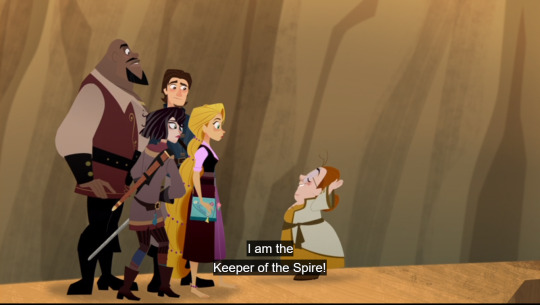

No, I’m not exaggerating. Calliope is the only recurring character in the series not to get royally screwed over by last minute rewrites and poor pacing. In fact her arc may have actually been improved by the dumb creative decisions of season three.
Which is a problem because she’s not a main character. Her story and arc shouldn’t be more well rounded than Rapunzel’s. It’s also clear, given how the writers try to pitt her as annoying thorn in the heroes sides that is only tolerated because she’s useful, that they weren’t expecting the general audience to identify with her, and so her subsequent portrayal as the most developed character in the show is fully accidental.
We Finally Get Some Indication of Cassandra’s Age

Well first off, we probably shouldn’t be getting such information about our deuteragonist this late in the game, but also, putting Cass in her early 20s recontextualizes her arc the same way Varian being 14 recontextualizes his conflict, but in the opposite direction. A 24 year old is more accountable for their actions than a 14 year old. Always will be.
And before people try to get all pedantic on me; yes she’s only 23 here, and Varian is currently 15. What I meant is those are their ages at the start of their villain arcs, because the linear progression of time is a thing.
This Joke Actually Highlights One of the Bigger Problems of Season Two

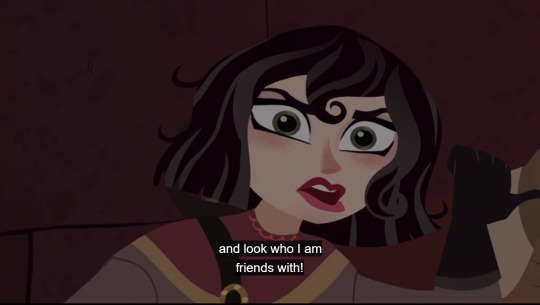
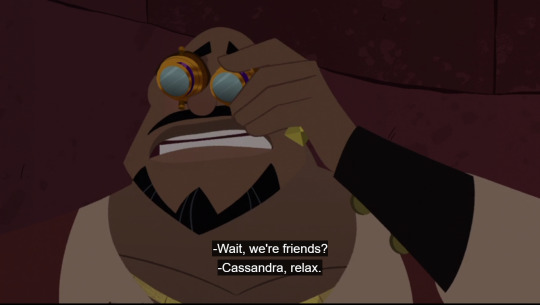
I laughed when I first heard this joke, but that’s cause I was under the assumption that they would go on to develop a friendship between Cass and Lance as the season went on. But they don’t.
Cass never has any focus episodes that aren’t about her failing relationship with Rapunzel. She never interacts with the other four people that she’s traveling with outside of group scenes like this. Not even with Eugene, who we spent the whole previous season establishing a bond with.
This undermines Cassandra’s arc in several ways. She less well rounded and developed without other people in her life besides Rapunzel; it ignores her place in the show as the older and wiser friend if she’s so majorly co-dependent upon only person. It also ignores what was set up in season one in order to push a certain narrative later that clashes with what we the audience already know.
Plus there’s the added effect of other characters getting poor representation within the story.
So Why Didn’t the Others Come Along Again?
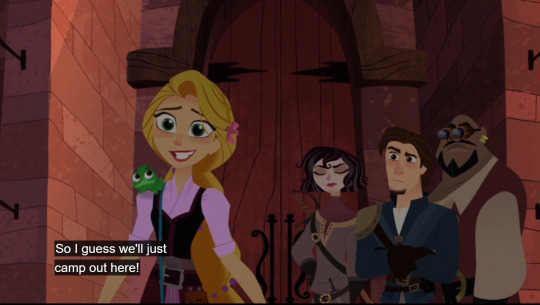
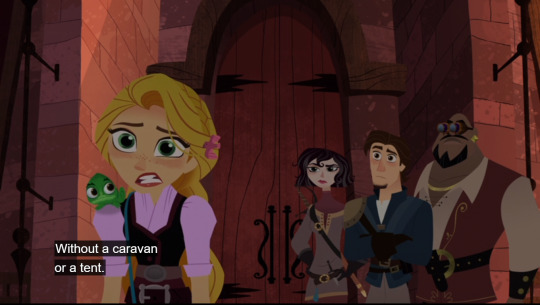
I understand not being able to take the caravan upto the top of the mountain, but the road was wide enough to get it up this far. Also it didn’t take you all day to get here so you could just walk back to camp.
But let's get to the real reason why the caravan was left behind. The writers wanted and excuse to get rid of Hookfoot and Shorty. Because they didn’t want to write them into the story. Because they have nothing to do with the overall plot and together they’re one too many characters to keep up with and give stuff to do to. Which begs the question of why they were ever included into the season at all.
Also why leave Adria behind? She was the one who sent them up here. She’s the one who has a vested interest in getting Rapunzel to the end of her journey. She’s the only one driving the plot at the moment, so why not have her present to do just that?
Rapunzel is a Hypocrite



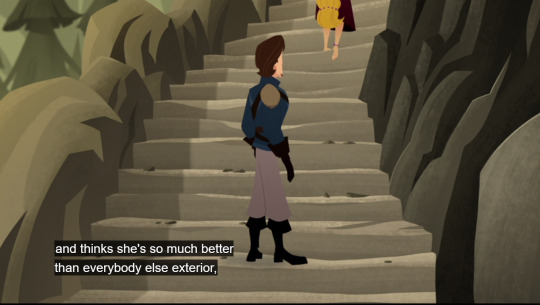

There’s not a single description that Rapunzel says here that couldn’t be applied to herself.
Which would be funny if the writers ever actually acknowledged this within the series.
Having parallels simply exist on their own and not actually inform the story is bad writing. Same with character flaws; acknowledge them, use them to advance both the plot and the characters, and build off of them to establish character dynamics. This is in part why Calliope is the better written character between the two of them.
Behold, the One and Only Time Lance and Rapunzel Hold a Conversation with One Another!
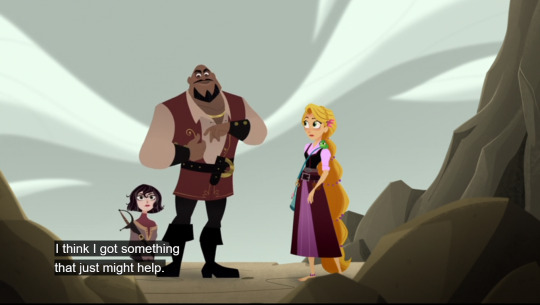

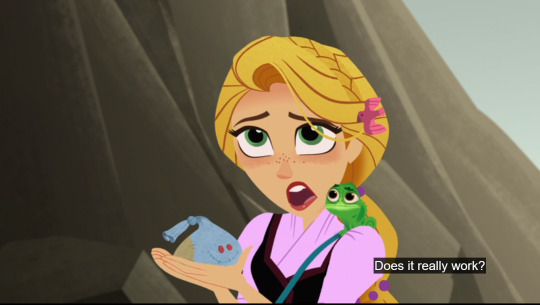
Speaking of characters not getting enough focus.... It’s just a set up for a recurring gag in the episode, but this is indeed the only point in the series where Lance and Rapunzel talk, about anything.
It’s not just Cass who is prevented from establishing relationships, it’s literally everyone. All of Rapunzel’s focus episodes alternate between Cassandra, Eugene, or a random side character. Cassandra only gets focus when with Rapunzel. Eugene only gets development with either Rapunzel or on his own. Lance is only ever shown interacting with Eugene or Adria, outside of some highly specific one off instances like here. Hookfoot is left out in the cold save for three episodes and two of them double as New Dream folder.
We’ve managed to pair the cast down to only six, as opposed to a whole kingdom’s worth of characters, and yet they have less development here than they did in season one. The group does not feel like a group, and that is a problem.
How is This Meant to be Encouraging?

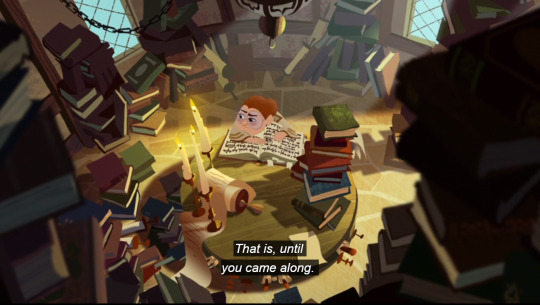
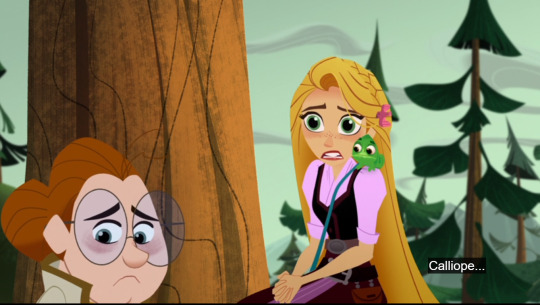
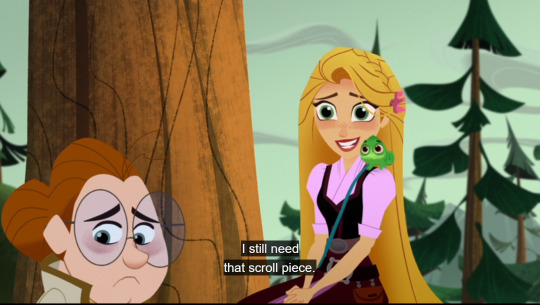

Ok, I get what the writers were going for here. Calliope has low self esteem. she feels useless because she’s lost her only support group, her mentor. So Rapunzel is ‘inspiring’ her to fulfill her dream of becoming the new keeper of the spire.
However, this is an incredibly bad take.
Calliope lacks self esteem because she’s lonely. Her dream of becoming the keeper is directly tied to her father figure, who up till now was the only person who gave a damn about her. She only wants to impress Rapunzel because she wants a friend and she believes that she needs to be useful in order to get that. And here is Rapunzel and the narrative reinforcing that belief under the guise of ‘achieving a dream’.
No fuck that!
You don’t need to have a ‘purpose’ to have friends.You shouldn’t have to prove yourself useful just be respected and included. Also, Rapunzel doesn’t even befriend her. She just uses Calliope to get what she wants and then avoids her for the rest of the show; only checking up on her out of obligation in season three.
So not only are we denied another female friendship in a show bereft of female relationships, but we also have a character who can be easily read as autistic by the audience needing to prove she’s useful to society in order to be accepted.
Ugh!
And yeah, I said autistic. We have a character who fails to pick up on social cues, hyperfixates upon her special interests, is rejected by society for trying to share these special interests, and she even pulls out her magic linked rings to fiddle with when stressed, which can be coded as a stim. I’m not saying that this was the writers’ intent, but nevertheless these are traits that people on the autism spectrum tend to identify with.
So how insulting is it to watch this episode and see someone you could relate to being constantly put down by the heroes behind their back and then never apologize for it, even when said character admits their own fault?
So Are We Ever Going to Get Any Background on this Spire?

So the spire is one of the few places that is plot important in the show. Yet we never find out why it exists, who built it, how it came to hold such important plot devices, nor the story behind the keepers who guard it. It’s just there, and that’s infuriating because it’s both a lack of much needed worldbuilding and lore.
Still A Better Dad than Frederic

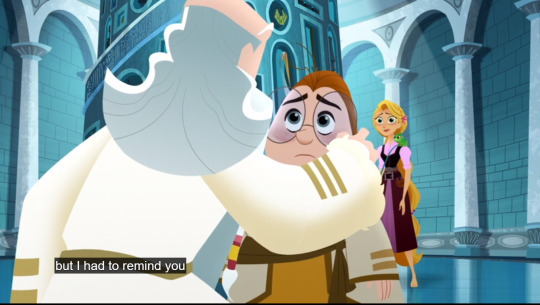
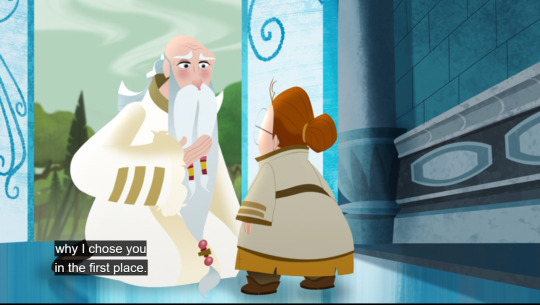
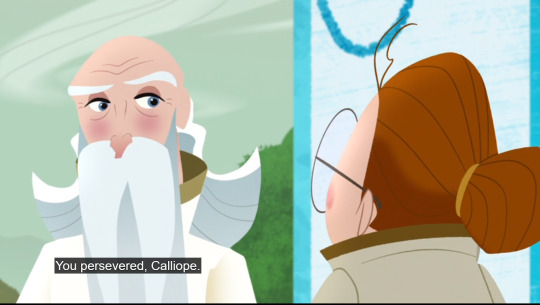
Leaving for months on end without telling you loved ones why and where you’re going is a shitty thing to do. Doubly so if its just to teach your kids ‘a lesson’. However, The Keeper still winds up being a better parental figure than most of the other dads (besides Cap, who is awesome) in the series. That’s how low the bar has been dropped by Chris and his weird ideas on parenting.
So What Was the Lesson Here?
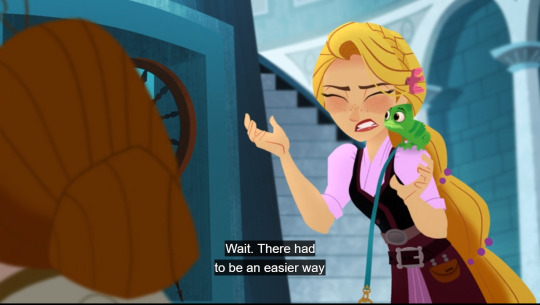
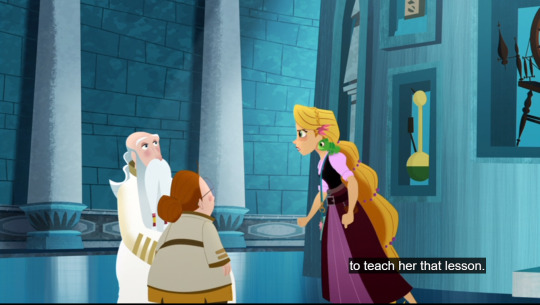
Ok first off, Calliope didn’t need to be reminded of anything. The Keeper says as much. She was always persistent. The only lesson that she does learn is not to lie but apparently that’s not what we’re supposed to take from this episode.
But what are we supposed to take away? Because Rapunzel doesn’t learn anything either. There’s no admittance of wrongdoing on her part and she does not change her outlook or behavior from this encounter.
Calliope at least learns to become more self assured after this episode and remains honest and true to herself once the episode is done with. Rapunzel however is the same. You can’t claim that this is ‘Rapunzel’s story’ (Chris’s words not mine) if it’s only random side characters who are allowed to grow. Which is yet another reason why the main cast of characters don't get the development and interaction that they should.
That’s also why Calliope is better written than the main character and she shouldn’t be. It’s a bewilderingly oversight of basic writing.
Conclusion
I don’t mind this episode. As I said in the beginning, it is one of the few non-filler episodes in season two. However, there’s a lot of problems with it to the point where I can’t actually call it good, just mediocre.
62 notes
·
View notes
Text
Another thing I would like to speak about this is my opinion I don’t want to talk over other trans people or the community I’m not speaking for the community as a whole this is just my personal opinion and I would like to state that I respect you and please respect my opinion and the opinions of others. Thank you. Here are some topics brought up that I’ve seen and I want to jsut state and voice my opinion if I offend you in any ways your are free to scroll. I value your opinions your thoughts but please be mindful and respectful of others.
THIS IS HELLA LONG BTW SORRY IN ADVANCE
(But please read the whole thing you don’t have to if you don’t want to)
1. "The vast majority of the individuals who have been examining this are cis, which is an issue first thing"
It truly isn't, there is no issue with this. There's nothing amiss with cishets imparting their insight, since anyone can have an assessment on anything. I see what your saying in some cases the don’t but as you saw on my other post they do in some events and cases the have a freedom to voice there opinions though.
2. I still can't seem to see a 'genderbent' rendition of a male character who needed bosoms and a dfab body. This is the first and most clear motivation behind why 'genderbending' is innately transphobic - it accepts that actual characteristics and sex are something very similar, and that you can't be female without additionally being dfab. (I will say AFAB)
Indeed, more often than not genderbent characters are not given characteristics and such generalizations. In any case, what's the issue with that? There's no issue playing into generalizations. You presently can't seem to see a genderbent adaptation of a male character who needed bosoms and is AFAB. That is narrative, and individual stories can't be acknowledged as obvious proof. Regarding why, the banner appears to introduce their conviction of actuality, when it clearly isn't. There's a lot of male genderbend characters (genderbent to be female) who do need bosoms, yet for what reason would it be advisable for it to significantly matter? Generalizations or not, there ought to be no issue here.
"It expects that actual attributes and sex are something very similar, and that you can't be female without likewise being AFAB." This is indeed another supposition, not a reality. Actual characteristics in sexual orientation are not something very similar, but rather it plays into the reality and generalization that actual attributes in sex jobs/sex generalizations are something very similar, to which they (as a rule) can be. You can be female without likewise being afab, and (expressed by and by) there are numerous characters out there that are trans and were being genderbent (tragically, however we shouldn't actually genderbend trans characters since it eradicates their sexual orientation except if when they're genderbent they're as yet trans, the exact inverse way.) and you could discover numerous trans characters being genderbent or such in games, manga, and media by and large.
3. "This is cissexism, and this is transphobic. The message that 'genderbending' says is that you should have bosoms and a v/gina to be female, and you should have a penis and a level chest to be male. I ought not need to clarify why that message is transphobic."
This isn't cissexism. The genuine meaning of cissexism: "Cis-sex-ism. Noun. Prejudice or discrimination against transgender people.” Stop twisting word’s definitions to fit your appeal and opinion. Stop believing threads such as this when they can’t even use the original definition properly. Genderbending is as simple as twisting someone’s gender so they fit into the stereotype. (a majority of the time, at least.) Biological genitalia are biological genitalia. Gender is defined by your brain, but we obviously cannot show that fact if there was a genderbend, because humans brains quite obviously do not show outside of the skull.
4. “The way 'genderbends' are completed likewise has unmistakably transphobic suggestions by they way it changes out the actual attributes of characters to make them 'the contrary sex' (The notion of there being ‘opposite genders’ is some fresh bullshit that I’ll cover later in this post) For instance, by giving a male character curves and breast’s while 'genderbending' him, the message is evident that this character was cis regardless."
This is being made way deeper than the notion actually is. Switching out physical traits to play into gender roles and gender stereotypes is not bullshit whatsoever. Giving a male character breasts and curves is as simple as what the action actually is. Genderbending, nothing more, nothing less. Nobody is actually reading into how detailed this is besides the original poster. But my issue is, what’s wrong with the message that the character is cis? Is there something wrong with cis people or there being cis characters? Trans people can still fit into these categories, and assuming trans people look different from cis people (whether in fiction or not) is transphobic, not characters fitting into the ‘cis’ category in your opinion. Once again, there is the assumption that the character was cis to begin with (unless the character has been stated on their wiki or in canon to be cis, to which most aren’t usually.
5. "'Genderbending' naturally infers that all characters are cisgender of course, and deletes any chance of these characters being trans. this isn't as plainly transphobic as the main point, yet it is hurtful to trans individuals inside being a fan spaces, as the presumption that all characters are cis until unequivocally expressed in any case pushes us out of media and eliminates whatever portrayal we may attempt to make for ourselves. "
Genderbending doesn't suggest anything, the first banner (and rebloggers) are indeed assuming. This obliges the hurried suspicion false notion, which is a coherent error that shows when a argument I’dbadly made. Genderbending doesn't suggest that all characters are cisgender as a matter, however it infers that the individual who composed this accepts so. There are cis looking trans individuals, and there are so to state, "trans looking" cis individuals. It doesn't eradicate any chance, in light of the fact that there can even now be trans individuals with genderbends, just as the way that there is trans genderbends out there. (despite the fact that it's avoided upon, obviously) It isn't unsafe to anybody at all, considering genderbends are quite often for no particular reason or investigation, there is no supposition that all characters are cis until expressed something else. (also, regardless of whether there is, the thing that's the mischief in that. there's no damage in having cis individuals not be expressed and trans individuals being expressed, on the grounds that cis individuals are the greater part.) It doesn't eliminate any portrayal at all, and I'd prefer to check whether operation really had any sources identifying with that, considering this has no sources at all and explicitly lies on striking allegations and suspicions.
6. "The third issue with 'genderbending' is that it is reliably cis male and cis female, and that is it. I have never seen people 'genderbend' characters by making them nonbinary or intersex. I have never seen a genderbend of a female character which made her a trans male in light of everything. 'Genderbending' proposes that there are only two choices concerning sex: cis male and cis female. There is nothing of the sort as nonbinary individuals inside this philosophy. Intersex individuals are bizarre, best case scenario. Agender individuals are minimal better than a far off fantasy."
Prior to anything: Agender doesn't exist. Non binary isn't actually viewed as a gender what I am saying is Non-binary is not technically considered a gender Non-binary (also spelled nonbinary) or genderqueer is a spectrum of gender identities that are not exclusively masculine or feminine—identities that are outside the gender binary and there is no “opposite” to genderbend a non-binary person there is no "inverse" to genderbend a non-paired individual. In the event that somebody endeavored to "genderbend" a non-binary individual to a male or female, individuals would get vexed regardless of what they wanted. There is indeed, nothing amiss with male and female genderbends. YOU (conversing with operation and the individuals who concur) continue expecting that they're cis, which is more transphobic than what you guarantee is transphobic. You can't "genderbend" a non-binary nor intersex character, or it would be designated "transphobic" or "eradicating their personality" to which it's definitely not. You could ensure that something contrary to non-parallel is intersex (since individuals who are intersex are hermaphrodites, brought into the world with both genetalia logically) however that would likewise recieve more disdain. It doesn't infer anything, and without fail, you expect that a character is cis. For all you know, they could be stealth trans, or openly trans but you never looked at their wiki; or they could not have their gender specified on the wiki or in canon. Agender does exist what I am saying is the gender your trying to portray or the norms when you look it up Some people's gender changes over time. People whose gender is not male or female use many different terms to describe themselves, with non-binary being one of the most common. Other terms include genderqueer, agender, bigender, and more this is. That is what I am saying in that area that people don’t identify as any gender as he/she or some are fluid. yes you could do “opposite” to genderbend a non-binary person. But if someone attempted to “genderbend” a non-binary person to a male or female, people would get upset despite it being what they wanted. But that would be transphobic and defeating the purpose of there identity as a whole. Sorry some of my Japanese was switched out and there are some words do not exist in English I apologize if anyone got offended. Yes you can genderbending a cis male/female to a non-binary individual but that wouldn’t be called genderbending would it?
7. “‘Genderbending’ ignores that it is impossible to make a character ‘the opposite gender’, because there is no such thing as an ‘opposite gender’. Gender is a spectrum, not a binary, but you wouldn’t know that from the way fandom spaces treat it.”
Gender is binary, however binary doesn't mean two. Gender is chosen in the brain. It IS difficult to make a character that is non-binary or intersex the contrary sex on the grounds that there is no opposite gender of non-binarynor intersex, at any rate in the event that you would prefer not to be called transphobic or more. You can make a cis individual a non-binary person but that wouldn’t be called genderbending?? The frigidity of genderbending is when a character's gender is changed. Usually in fanfictions or fanart. The name should be changed since it is heavily confusing since genderbending also means in other definitions gender bending is sometimes a form of social activism undertaken to destroy rigid gender roles and defy sex-role stereotypes, notably in cases where the gender-nonconforming person finds these roles oppressive.
8. “Of course, there are some reasons for ‘genderbending’ cis male characters into cis females that will always get brought up in discussions on the politics of ‘genderbending.’ The most frequent is that cis girls, who only see themselves as one-dimensional characters in media, want to have characters like them who are just as multifaceted and developed as the male characters that we are given, so they make their male faves female to give themselves the representation they desire. This is a decent reason for ‘genderbending’, but it does not excuse the fact that the way in which ‘genderbending’ is done is inherently transphobic, and it gives fans yet another excuse to ignore female characters in favor of focusing on their male faves.” This whole spot I shouldn’t even have to explain. This is once again being read into way too much, there is no ‘politics’ of genderbending. There is just genderbending, plain and simple. Cis girls can want to see stuff in genderbending, as can cis guys when they genderbend a female character male to see how they’d react and such. Genderbending has no politics, besides that it’s “transphobic” to some.
9. “Another reason for ‘genderbending’ that I’ve heard is ‘it’s for the sake of character exploration - like, what if this character had been born as male/female instead?’ This excuse is cissexist and transphobic from first blush. The idea behind it is that someone ‘born as female’, aka with breasts/vagina will automatically be a cis female, allowing fans to explore what that character’s life would have been like if they were female. Why not explore the possibility of a character being designated female at birth, but still identifying as male? Why do you need a character to be cis for you to find their personality and life interesting to explore? Why do you automatically reject the notion of your fave being trans? If you want to explore what it would have been like for your male fave to have struggled with sexism, consider them being a trans woman, or a closeted afab trans person.”
Yes, character exploration. It’s not cissexist nor transphobic. Whether the character was genderbent cis or trans, it’s not about their genetalia to ‘explore’ the character, but that’s just what you thought it was. Character exploration in this case as in “How will people treat them differently due to possible sexist/misogynist laws and/or character behavior that’s normally in males inside a female, or vice versa? How would people and the law treat this female character who’s shy, if she was a male? How would people and the law treat this male character who’s obnoxious and loud and determined, if he was a female?” Not “How different will this character’s life be because they have a penis or v/g?” You reducing character exploration down to genitalia is blatantly transphobic more so than you think, as well as just downright rude.
10. ‘Genderbending’ does harm trans people. It perpetuates dangerous cissexist notions and the idea of a gender binary being a valid construct, erases nonbinary and intersex people, and others trans people. These are what we call microaggressions - they are not as dangerous as outright harassment and assault, but they enforce and support a system and ideology in which we are other, and we are worthy of hate and violence because we do not fit in.
Genderbending does not harm all trans people inherently i am talking to a group of people which is moderately huge but I am not speaking for all of the community whatsoever, considering trans people also like to genderbend characters. It plays into stereotypes and you thinking gender is a spectrum is more harmful that getting upset that someone thinking “How would people treat this character if he/she was the opposite gender?”. It does not erase non-binary nor intersex people, because you could throw them in if you really wanted to, but you’d also be the person who would call that act transphobic or ‘erasing their identity’. This is not a microaggression whatsoever, but rather a personal grudge based on assumptions you think are true, and treating your opinion as fact. That is all.
I don’t see or think why genderbending as a whole is transphobic the name should be changed though but genderbending as a whole is not bad sure they’re are issues but It is not transphobic.
16 notes
·
View notes
Note
I have seen many, MANY discussions/debates about ca:cw and I have never seen anyone mentioning that Rhodey's injury was a metaphor. How did you get that idea?
Short answer: I’ve actually read a lot on the subject. I’m teaching a media studies class right now called “What Can Superheroes Tell Us About Psychology?” (because that’s the kind of shit you can get away with at giant universities) and hoo boy are superhero narratives More Ableist Than Average. Anywhoo, a few of those readings:
I’m quoting hard from the chapter “Hyper-Normative Heroes, Othered Villains: Differential Treatment of Disability in Marvel” in a book on disability studies because it’s free. A relevant passage:
“These metaphorical portrayals all fail to engage with disability as a social category and as an individual identity, thereby ignoring its context… Nick Fury’s missing eye does not change his aim with distance weapons (e.g. Captain Marvel) or piloting software. Instead, it recurs in the films largely in metaphorical lines such as Fury’s commenting on the death of a friend with ‘I just lost my one good eye’… One character in Avengers even questions the lack of accessibility in Fury’s multi-monitor computer console, and Fury’s assistant simply answers that he must turn his head more often to compensate. The franchise thereby emphasizes that Fury’s missing eye is only a metaphor for his discernment and ability to see details that others have missed, rather than a truly integrated part of his character or even an accurate portrayal of that disability.
“8. This treatment of disability as metaphor persists throughout the MCU. In Captain America: Civil War, superhero War Machine incurs a permanent spinal injury while fighting on behalf of his best friend Iron Man. Later on, rival superhero Hawkeye… ‘You gotta watch your back with this guy. There’s a chance he’s gonna break it.’ The film then equips War Machine with a fantastical prosthesis that essentially nullifies his disabled experience through giving him the same range of motion as his non-disabled [abled] teammates, entirely without side effects or need for maintenance. The MCU films thus present disability as a metaphor for inner morality and characterization. War Machine has few experiences of being a disabled man through his spinal injury, but is instead emotionally ‘disabled’ by the damage to his social standing he has incurred through his friendship with Iron Man… The MCU thereby offers no critique of ableism or inaccessibility, instead continuing to localize disability as a problem with the body and the individual.”
Death, Disability, and the Superhero: The Silver Age and Beyond by José Alaniz is also a fantastic resource, and you can buy it for money here or hopefully find it at a library if you have no money. A few of the relevant points from his book:
Superhero stories often treat disability as a��“problem” that must be “solved” through in essence nullifying the disabled experience of the character(s) through superpowers that run directly counter to the disabilities and/or fantasy “cures,” e.g.
Daredevil is blind BUT navigates the world in a way similar to sighted people due to his “radar sense,” meaning that he doesn’t get to have a lot of the lived experiences of blind individuals
Don Blake is mobility impaired and uses a cane BUT his cane transforms into mjolnir and imbues him with the power of Thor, meaning that he spends most of the story moving like a nondisabled person
Hawkeye is hard of hearing sometimes in some of the comics, BUT he often gets magical cochlear implants from Tony Stark that cause him to stop being hard of hearing
Characters that are disabled and remain disabled tend to be villains whose villainy is either implied or stated to come directly from their bitterness over being disabled, e.g.
Doctor Doom hates that he’s scarred by an explosion so much that he wants to take over the world to get revenge on the Fantastic Four
The Lizard only transforms himself because he ignores all scientific and ethical boundaries in his desperation to stop being disabled
Doctor Poison is described by herself and other characters as a “monster” for failing to (unlike Wonder Woman) conform to White Western conceptualizations of female beauty
Characters like The Thing, She-Hulk, and Bizarro have the potential for some really interesting disability narratives. However, the same publication pressures that prevent permanent injury or death to the characters also prevent the inclusion of “serious” “real-world” issues like discrimination unless it’s metaphorical (e.g. anti-mutant fearmongering as a metaphor for anti-AIDS prejudice).
The Big Damn Foundational Text on the intersection of disability studies and media studies is Narrative Prosthesis: Disability and the Dependencies of Discourse by David T. Mitchell and Sharon L. Snyder, and you can pay money for it here but it’s also available at a lot of libraries. Anyway, a couple of relevant points from that book include:
Disability portrayals abound in literature going back to pretty much the dawn of history, but most of those portrayals suck ass because:
Most disabilities are treated as metaphors rather than demographic characteristics, which means that the disabled character doesn’t get connected to other people with disabilities (including those in the real world) and offers no commentary on ableism — if Richard III’s spinal misalignment is just a metaphor for him being “twisted” inside, it doesn’t allow readers with spinal misalignment to identify with him
Disabled characters tend to exist to teach lessons to nondisabled characters rather than having their own journeys — Tiny Tim isn’t a person in A Christmas Carol, he’s an object lesson for Scrooge
Many disabled characters either get “fixed” so that they look outwardly “normal,” or their “ugliness” is used to make concrete the abstract “ugliness” of their personalities
Disability is treated as a “problem” that demands an explanation – Captain Ahab’s prosthetic leg and Joker’s facial scarring are treated as automatically demanding the question “why are you like this?,” even though no one would ever ask the same thing of their nondisabled co-characters
Authors’ implicit ableism tends to come out in their horror of disability, such as when they portray disabled characters preferring death to disability, going to extreme lengths to avoid or nullify disability, and/or declaring themselves “worthless” or “burdensome” in light of disability
Discomfort with disability — another form of implicit ableism – also comes out when disabled characters are overwhelmingly “killed or cured,” meaning that they don’t get to end their stories as living individuals who are still, in practice, disabled
ANYWAY, that’s a long-winded way of saying that I also haven’t seen any critics specifically talk about Rhodey’s disability as a metaphor first and a part of the character second, but that that doesn’t mean the shoe don’t fit. When someone asks about the Accords in Infinity War, Rhodey also says he supported them but then “I’m pretty sure I paid for that,” and gestures at his own paralyzed legs. He also also says in Endgame “I wasn’t always like this… but we work with what we’ve got” when talking to Nebula, BOTH about the fact that he’s disabled and about the fact that half the universe is dead and they’re all struggling to cope with that fact. It keeps getting used as a metaphor and keeps NOT getting used as a part of his identity. LET THE MAN TALK TO SOME OTHER DISABLED VETERANS FOR TWO SECONDS, FOR FUCK’S SAKE.
A couple of other (free!) readings that talk about that general problem of “we love superheroes and we hate ableism, now what?” even if they don’t mention Rhodey specifically:
“Reevaluating the Supercrip” by Sami Schalk connects media portrayals of the paralympics to media portrayals of Captain America and the Doom Patrol. (I swear to god it makes sense in context.)
“Seven Roads to Justice for Superheroes and Humans” by Mikhail Lyubansky gets into the glaring (for me, anyway) question of “why the fuck are sci fi psychologists all so evil and useless?” by explaining why Harley Quinn must be evil for Batman to be a vigilante.
“Superhero Comics as Moral Pornography” by David A. Pizarro and Roy Baumeister (again, I swear it makes sense if you read it) discusses the evolutionary tendency to judge people based on disabilities and why it’s so popular in superhero stories specifically.
Anyway, you probably weren’t looking for an entire annotated bibliography in response to that question, but I’ve never been one to use five words when 500 would suffice.
#disability#ableism#media studies#disability studies#nothing to do with animorphs#war machine#james rhodes#iron patriot#rhodey#mcu#marvel#marvel negativity#superheroes#jose alaniz#sami schalk#disability theory#psychology#long post#avengers#mcu negativity#captain america: civil war#jim-hopper-superhero#asks#paywalls#if you'd like any of the ones that cost money#hit me up and i can scrounge a pdf or two
378 notes
·
View notes
Text
More Female Characters to Avoid in Your Writing
A long while back, I typed up some posts ranting about characters and tropes I disliked. These were Male and Female Characters to Avoid in Your Writing, and they’ve become my most popular posts yet. Recently, I was struck by some topical inspiration, and decided it was time for a sequel!
One again, these are my personal, subjective opinions! No one dictates your writing or portrayals but you, and no one can or should decide how you consume fiction. Also, as you may notice, I actually like most of the ladies below; I just don’t like certain aspects of their portrayal.
Enjoy, and happy writing everybody!
1. The Daenerys (i.e. the spontaneous war criminal)
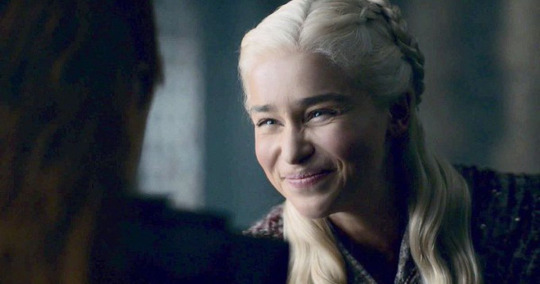
Image source
Who she is:
The formerly heroic Mother of Dragons, who randomly charbroiled a city full of innocent people.
Why it sucks:
I’m not even talking about this from a feminist standpoint, or how one of the most consistently heroic and powerful female characters took an abrupt and undignified backflip into the Dark Side. I’m speaking from a writer’s standpoint.
Regardless of whether you liked Daenerys, she was rivaled only by Jon and Brienne as the show’s most consistently heroic character From locking away her dragon children to ensure the safety of her subjects, to freeing countless enslaved citizens, she’s spent a decade proving herself to be an altruistic and noble figure. And then, in the final two episodes of the entire show, the writers dracarys-ed that shit.
For some comparison, just imagine how ridiculous it would be if Jon Snow suddenly went batshit and started hacking up citizens because he was feeling stressed. That’s about as plausible as Dany’s sudden passion for genocide.
And for the record, I’m not opposed to Daenerys becoming Mad Queen. If it was done properly. This would mean informing the actress far in advance so she could modify her portrayal accordingly (which they didn’t), and building up to it through foreshadowing and established attributes. Not at the last fucking minute.
Honestly, the only characters who remained narratively consistent to the very end are Drogon and Ghost, who are both precious babies who did nothing wrong.
How to avoid her:
Decide as early as possible where a character arc is going. Contrary to what Game of Thrones seems to believe, the character arc is important. It should have a beginning, challenges that incite development, and a satisfying conclusion that showcases how a character has changed and evolved.
And if you didn’t decide early? You still have to come up with a conclusion that makes sense for your character, and not slap on the most unexpected ending possible in the name of Subverting Expectations.
On that note? Subverting expectations isn’t always a good thing, and a reader predicting your ending isn’t the worst possible outcome. Focus on telling a good story.
2. The Rayon (i.e. the transgender stereotype)
Who she is:
A transgender woman (portrayed by the male, cisgender Jared Leto) dying slowly of AIDS in Dallas Buyer’s Club. Her role in the narrative is to teach the supposedly heterosexual (more on that later) main character that queer people are human beings.
Why it sucks:
Rayon is many things in Buyer’s Club, and most are firmly rooted in stereotypes. She’s a sassy, flirtatious, clothing-obsessed, self-loathing, drug-addicted prostitute. She’s hypersexual, but never treated as romantically desirable. She’s tragic, but also one of the few consistently comedic characters in an otherwise bleak film.
It’s her job to gently goad the main character into treating her with basic respect, but he never quite gets there. He refers to her with male pronouns throughout the entire film, and never acknowledges her as a woman. At one point, he aims a gun at her genitals and offers her a “sex change operation.” Which, is supposed to be comedic.
This isn’t to say that there are no sassy, flirtatious, clothing-obsessed, self-loathing, drug-addicted transgender sex workers, nor is there anything wrong with “stereotypical” trans people. It isn’t the job of the marginalized to dispel stereotypes. And if real trans people had created and portrayed Rayon, she could have been a realistic, dynamic, and compelling character.
And I say “created” because Rayon is strictly fictional. Outside of this film, she didn’t exist.
“Well, at least they tried to offer representation!” you protest. “What else was it supposed to be about? A straight dude in the AIDS epidemic?”
Well, no. Though the main character, Ron Woodroof, is presented to us as a violently homophobic, transphobic, womanizing asshole, the real Woodroof was, by all accounts, kind-hearted, open-minded, and bisexual.
What could have been a powerful story of a queer man defying his diagnosis, living joyfully and meaningfully, and helping to prolong the lives of countless AIDS-sufferers, was instead watered down to a story of a straight, pugnacious asshole and his stereotypical, long-suffering, transgender sidekick who dies to Teach Him Compassion.
How to avoid her:
Read books by trans people. Consume media they create or endorse.
List of youtube channels created by trans people here, and 21 books for trans awareness month here.
Put out a special call for transgender beta readers to point out mistakes, misconceptions, and offer tips on an authentic portrayal.
Garner insight into their perspective and experiences, and give them personalities outside of being trans.
3. The Piper Chapman (i.e. the unflavored oatmeal)
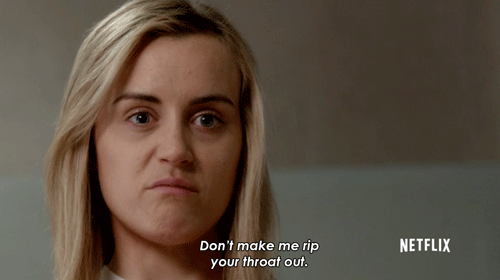
GIF source
Who she is:
The “protagonist” of Orange is the New Black, and its least compelling character. She and Larry are the sort of people who would ask me for a threesome on Tinder.
Why it sucks:
Piper’s hook is that she’s a privileged, affluent white woman who unjustly finds herself in prison for -- well, for crimes she committed. But expected to get away with, because, Privilege.
This isn’t to say Piper is boring. She’s far from likable, but being likable and being boring aren’t the same thing. In another series, watching a relatively cushioned, naive, bourgeoisie woman string along various significant others, thoughtlessly incite violence, and navigate an unfamiliar prison setting would make for thought-provoking and hilarious satire.
But when compared to her charismatic supporting cast, with richly developed backstories, motivations, and relationships, she’s painfully bland. I would much rather watch a series centered around Suzanne, Nikki, Taystee, Poussey, or even Pennsatucky. They’re just more developed, opulent, enjoyable characters.
It could be argued that Piper is the viewpoint character, whom the audience is supposed to relate to. But I can assert that I don’t relate to Piper. At all. Her lack of empathy towards others -- such as leaving Alex after the death of her mother, cheating on her fiance, and inadvertently starting a *ahem* white power gang -- alienated me to her.
Which might not be such a bad thing, but Piper is (supposedly) the protagonist. We don’t need to like her, but we should probably be able to relate to her.
Or maybe I’m just jealous that hot women aren’t inexplicably fighting over me.
How to avoid her:
Your protagonist doesn’t have to be the most likable character in your story. They don’t even necessarily have to be the most interesting character in your story. And certainly not the most morally good, powerful, or knowledgeable. But the viewpoint character is the character who we spend the most time with, and from whose eyes we perceive the story. It’s important that we understand and relate to them emotionally.
Look at examples like BoJack Horseman, Holden Caulfield, Tony Soprano, Beatrix from Kill Bill, Mavis from Young Adult, Nadia from Russian Doll. All are complex characters, with varying degrees of moral ambiguity. Yet we can empathize with them emotionally and identify with them. Even if we’ve never been in their situation, we see where they’re coming from.
4. The Charlie (i.e. the dead lesbian)
Who she is:
One of the few recurring openly queer characters in the incredibly long-running Supernatural. A lesbian who’s journey was (sort of) brought to an end when she was killed and dumped in a bathtub to incite drama.
Why it sucks:
I love Supernatural but it can be remarkably tone deaf towards queer people, women, and marginalized groups. Which, probably merits fixing, considering its following is largely comprised of queer people, women, and marginalized groups.
I probably shouldn’t have to explain why killing off women and queer people for drama is Bad, but I’ll delve into its history a little: from what I’ve read, censorship laws of the twentieth century forbade the portrayal of queer people unless they were ultimately killed or “reformed.” This is why so much LGBTQ+ fiction is essentially gay tragedy porn, and why gays are so frequently buried to aid in the emotional narrative of their straight counterparts.
That’s not to say queer people can never be killed off. I might not have an issue with Charlie’s death (especially in a show as violent as Supernatural), if she weren’t the only openly queer character at the time.
And there’s plenty of room for representation! If Dean was openly bisexual, if angels were vocally confirmed to be nonbinary, and if there were more recurring, respectfully portrayed female and sapphic characters, Charlie’s death might not feel like such as slap in the face. But as it is, it feels like a contribution to an ugly pattern.
In fairness, Supernatural has since improved in its portrayal of queer people: two gay male hunters were introduced and given a happy ending, an alternate universe version of Charlie was introduced to the cast, and God is portrayed as a bisexual man.
Yes. All of that happened. You have to see it to understand.
How to avoid her:
Educate yourself on the history of censorship in the LGBTQ+ community, as well as hate crimes and decreased life expectancy. Make sure you aren’t contributing to the suffering of queer people.
If you have only one confirmed queer character in the midst of a very large cast, I’m inclined to think you need more. You could say I’m BI-ased on the matter, though.
Look up “fridging,” and think about how many stories use the death of female characters to incite drama for men.
5. The Allison (i.e. the reformed feminine)

GIF source
Who she is:
She’s one of the most interesting members of the Breakfast Club, and that’s saying something. A self-proclaimed compulsive liar who will “do anything sexual” with or without the promise of a million dollars (as well as one of the most quotable characters in the film) she demonstrates the emotional pain and complexity that’s often ignored or shrugged off as teen angst.
And then she gets a makeover and a hot boyfriend, and suddenly everything’s better.
Why it sucks:
It would be one thing if Allison’s problem was that she didn’t feel pretty or desirable. But she never (to my recollection) offers any indication of that, and that’s part of what makes her such a refreshing portrayal of insecurity. She’s emotionally neglected by her parents, and that is appropriately treated as devastating.
It’s a complex and beautifully-portrayed problem that deserved far more than such a superficial, slapped-on solution.
Similarly, there’s no reason why Allison is paired up with the jock at the end of the film. Neither showed any romantic interest in one another until her unnecessary makeover.
A much better ending to her arc would be her finding acceptance among her newfound friends, and finally garner the recognition and acknowledgement she never got from her parents.
I was torn between using Allison for this example, or Sandy’s makeover from Grease. In both, girls are encouraged to alter their appearances to solve plot-related problems. And both were “fixed” to conform to some standard of femininity or feminine sexuality that they didn’t meet before.
How to avoid her:
If a character feels the need to change their appearance to accommodate others or be respected, that should probably be treated as a negative thing.
Your character’s appearance can be a good tool to represent emotional changes. If they alter their appearance, there should be a meaningful reason behind it -- outside of fitting into societal norms or garnering the approval of others.
A girl putting on makeup isn’t a groundbreaking plot point, and girls who don’t perform to standards of femininity aren’t broken or deficient. They don’t need “correcting.”
#writing#writing tips#writing advice#game of thrones#daenerys targaryen#jon snow#game of thrones spoilers#transphobia#orange is the new black#supernatural#fridging#homophobia#charlie bradbury#the breakfast club#grease#sexism
2K notes
·
View notes
Text
This is what it looks like when you can't see past your own bias.
Aka: what happens when your lived experience is inconvenient to the narrative.
By Andrea Thompson
Watching the movie “Brian Banks” is...awkward. To some extent, it's a classic sports underdog movie, but the struggles Brian Banks had to overcome are anything but conventional. As the movie continually points out, he's exceptional. And he is, in more ways that this movie is aware of.
Based on a true story, which the movie is quick to point out with dramatic music (uh oh), the title character, played by Aldis Hodge, muses on his great love for football, which he was on track to play professionally until he was stopped in his tracks at 16 years old. It's how he was stopped that would make anyone pause; Banks was falsely accused of rape by a classmate.
After some bad legal advice leads to jail time and some years struggling to navigate the conditions of his parole (and having to register as a sex offender), Banks struggles to simply find a job while simultaneously fighting to clear his name and reclaim his life. He also repeatedly writes the Innocence Project and asks them to take his case. Refusing to give up even after they reject him, Banks goes to meet with the lawyers on the project in person, first convincing them to give him advice, then take him on, and finally, actively fight for him.
It's impossible not to get invested in just how much Banks had to overcome, from his poverty-stricken childhood and the various legal road blocks that threaten to end his fight before it even begins. Banks wasn't imprisoned, so he was not a priority for the Innocence Project, and since he took a plea rather than going to trial, he needs completely new evidence rather than simply using what was already discovered. He also has to stay sane in jail, especially when he's put in solitary. Banks even took the initiative and managed to record his accuser recanting her confession.
Except. Except. Well, there was going to be misgivings about this film being released during the #MeToo Era, wasn't there? That the film would fully embrace Brian's perspective and his struggles is natural, even admirable. However, this type of story demands more, and what the movie doesn't say is far more noteworthy than what it does. It doesn't mention that the percentage of false rape accusations are not only incredibly low, the conviction rate for them is even lower. It limits its empathy for what many women have gone through to one scene, where Banks's love interest Karina (Melanie Liburd) reveals she was raped in college, and how devastating the aftermath was for her.
Even if there's little to no doubt of Brian's innocence, it's hard not to wince as his accuser is subjected to the kinds of questions which are used to discredit actual victims, as the men questioning her ask just what she expected to happen when she went off alone with Brian, why she didn't shout, etc. It also doesn't help that Brian and the people assisting him are all easily identifiable as various levels of middle class while his accuser and his family are...not so much, let's just say.

Yes, Brian Banks suffered a terrible injustice, and he proved himself to be exceptional not just for his athletic prowess, but the strength of character it took to fight for the truth over a period of years. The performances are also incredible, and help to elevate this movie above the simplistic melodrama it would otherwise be, although it also depicts faith and how it can be a bedrock for those in pain more respectfully than most mainstream films are typically capable of. It's all in service of someone who deserves to be vindicated, but it shouldn't have to come at the expense of so many other victims.
Rating: C-
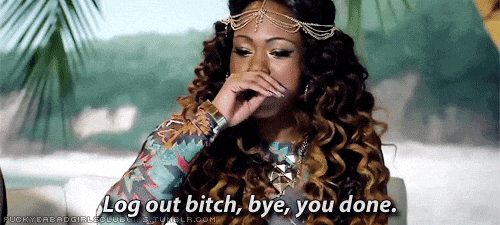
Fortunately I wasn't the only one who took issue with this "review".
Cassandra3
This is a disgusting review of a great film. I can not believe that I read what I just read. And also why did you put "(duh duh)" after saying it was a true story. You give Feminism a bad name and I am embarrassed to even have someone like you even pretend to fight for women's rights. SMH
Andree4
This is a wretched review, that quite possibly reveals deep-seated implicit biases, on your part. You didn't review the movie, you made a political statement, rooted in radical feminist, and male-hating rhetoric. This man, along with other men of similar misfortunes, is the victim-not the woman who accused him. He is a human being, that has every right to have his story told, unmolested by contrived issues that would shift the focus off of him, onto a non-victim. And so what if his economic status is above his false accusers status: does it then justify her lies against this man, that resulted in his imprisonment? Nice attempt at a fake out, but I'm sorry-you miserably failed. At the core it appears as if you feel more sorry for false accusers of men, than the men who are falsely accused by these liars. It appears that way, in light of you inserting that jab. This pitiful analysis betrays your binary agenda: all women are truthful and good, in spite of potential liars and deceivers amongst them, whereas all men are just BAD-because they're men. And God help the men if they are assertive, confident and forthright, for then they'll be accused of having TOXIC MASCULINITY, whereas a woman with those same qualities will be labeled a BOSS. Look at the woman in the mirror...
Crystal4
This is a horrible review of the movie. It doesn’t even review the movie. It more about your perspective in the Brian Banks case. I have never seen so much bias. You make it sound like the movie forces you to see Brian Banks as a victim. When in all reality he IS the victim. He was accused of raping his girlfriend and it was completely false. It was prisoned and register as a sex offender. His whole life changed on a lie from a girl who’s family wanted money. What other victims did it come at the cost of ? He just telling his story. SHOULD HE LIE OR WATER IT DOWN, BECAUSE IT HURTS YOUR SENSITIVE IDEALS ? Should he not get justice? Please explain to me what you are trying to say.
Jesse4
Even in the face of a story that proves there are two sides to this extremely challenging issue, you demonstrate that you have no regard for men who can see their lives completely destroyed when false allegations happen. This review is equivalent to me watching The Accused then writing about how it was important to shine a light on violent gang rape, but not if the movie didn’t properly explore situations where men were jailed over false allegations. I also love how you threw in the problem with WHITE MEN when the movie is about a BLACK WOMAN FALSELY ACCUSING A BLACK MAN OF RAPE. Your ideology clouds your vision to where the hierarchy of victimhood drives all understanding of right/wrong and how any narrative should be interpreted. It’s transparent to 90% of us, but your kind lives in an echo chamber. You aren’t more educated...you’re more indoctrinated and I’m looking forward to the cultural shift that sees your viewpoints thrown in the dustpan of history.
Gordon Shumway4
At no point in this cinematic review did you review the movie on its story-telling, 'watchability', acting, or general movie presentation. You took your biased, personal opinion about the story, and decided that it does not fit your false narrative that the female is always the victim.
117 notes
·
View notes
Text
A Brief History Of Transphobia In Horror Movies Feat. A Small Window Into The Reality Of Being Trans Cause Let’s Face It It’s Way Scarier Than Any Horror Film
It combined the eerie atmosphere of supernatural horror with the twists and turns of a psychological thriller - by all means An Incident In Ghostland (2018) was a great film.
It drove an innovative plot around tight bends of classic horror tropes and brought us skidding back to the ultimate psychological horror ending: we never really know what’s real and what’s not.
But this film should’ve crashed within the first 15 minutes.
And all that should be left in the wreck is a lipstick in the shade ‘Harlot Red’.
We already know that the struggle for trans rights - let alone with trans representation in the media - is a worthy fight. It has not been helped by the horror genre.
It’s time to change that.

It began with Buffalo Bill.
“Would you f—k me? I’d f—k me.”
It’s one of the most iconic horror films that have been put on the silver screen. But the thing is, when people were walking out of the first screenings of The Silence of the Lambs in 1991, they were traumatised by the disgusting acts Hannibal Lecter would commit on-screen.
They were not protesting Lecter’s former patient as they swiped on makeup, tucked their genitals between their legs, and paraded their desired body in the mirror. This quick pre-murder ritual is the most prominent portrayal of transgender identities, even if - as Lecter says - they are not trans.
From the scenes in the film to the pages of the novel it’s based on, we see Buffalo Bill’s gender dysphoria, but Lecter instead suggests their apparent trans-ness is rooted in something else - something far more sinister, something that never actually gets explained.
All we know is they want to create a ‘woman suit’ by murdering women and skinning their bodies.
Buffalo Bill thus brought to light a portrayal of gender dysphoria that claimed those that were questioning their gender identity were obsessed by gender.

So obsessed, in fact, they would go to extreme lengths to fulfill their desires by killing women and taking their ‘parts’ for themself.
This is also explored in another horror classic: Psycho (1960).
This film defined the horror genre, and put the slasher on the map. And if slasher films weren’t guilty enough for their portrayal of women, they further followed the J.K. Rowling school of thought and gave trans women a new separate character-arc.
Norman Bates is yet another horror icon known for dressing as a different gender, and then killing women. Whether they’re doing so to protect their identity or to keep the memory of their mother alive, we see another man don a wig, pull on a dress, and whip out a weapon of their choice.
The only difference is that Norman does become his mother (and thus a woman) on a permanent basis - only when he is officially declared insane and institutionalised.
The more deranged they become, the more crimes they commit, the more of a woman they become. By officially crossing the gender lines, they officially become monsters.
“But weren’t Norman Bates and Buffalo Bill based on a true story?”
Ed Gein was a serial killer who murdered countless women, mutilated their bodies, and used their body parts to create various household furniture and items of clothing. But it was Gein’s creation of a ‘woman suit’ that would allow them to crawl into their beloved mother’s skin which confirmed that they were the original inspiration behind these movie villains.
Despite debate on whether Gein was in fact transgender, a majority believe via police evidence and interviews that they would identify as trans by modern standards.
This brings us to an important point:
To an extent, these films portray trans peoples accurately. Funnily enough, trans people are actually people (shock horror). This means that they can in fact be murderers.
But what these films don’t get right is that they all portray trans people as exactly the same. Like, exactly the same. As in they could at least have tried to be a bit more imaginative.
So, when I was watching An Incident In Ghostland one Sunday evening, I was reminded of the same trope yet again. Well, not reminded, per se. ‘Smacked in the face’ is probably a better phrase to use.
But thankfully, Ghostland did throw in something different.
They chuck in a character that belongs in some found-footage haunted asylum movie!
*Slams laptop shut*
In Ghostland we see two sisters get stalked, held captive, and sexually assaulted and raped by a mentally impaired man and a trans woman. But despite the dominance of the scenes involving the torture, assault, and rape of the women, I want to focus here on the decor of the house they were held captive in.
The house was full of hundreds of vintage dolls.
From the striking image used on the movie poster to the garish aesthetic one can only imagine was inspired by Annabelle, dolls that are painted, dressed, and positioned for use by the woman and the man is central to the plot.
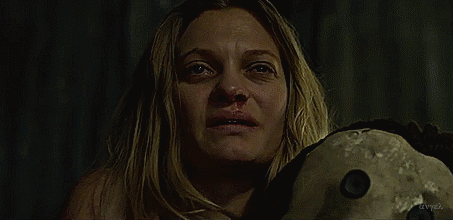
Its the dressing of the sisters in traditional feminine outfits and the application of doll-like makeup to join the other dolls in the house which fits the trope we just can’t escape from.
(No matter how fast we run.)
The Candy Truck Woman, as she is also known, dedicates herself to the process of holding their victims captive and making these women into traditionally feminine objects. It’s the process of creating extreme femininity that defines her role.
Well, that and the portrayal of her trans identity which only goes as emphasising her masculine features. This is embodied by the death of the villain:
Her wig gently slips off her head just before her corpse slumps to the floor.
This suggests that her trans identity is intrinsically linked to her crimes. When she dies, the girls are finally free from her control, and the doll facade ends. She too is apart of the facade. She is reduced to being a bloke in a wig.
The only redeeming feature of this movie?
She is correctly gendered by the credits as the Candy Truck Woman.
*flips through notes*
Yep, that is literally it.
So, why are trans people - specifically trans women - given such roles in the horror genre?
It’s been 60 years.
It’s been 60 years since Psycho earnt its status as the ultimate horror film. But still, to this day, we are presented with horrific portrayals of trans women. It isn’t their acts that define them, however.
If Buffalo Bill was murdering women and comfortable with their gender identity, it would just be another tragic tale of a brutal act. Buffalo Bill is horrifying because they dress like a woman and then commit the acts.
Unfortunately, this link ultimately suggests that those that identify as trans either are or can become mentally unhinged. From there it’s a short trip to becoming obsessed with gender and whoops they’re cold-blooded killers!
And for the uninformed, this almost appears to follow basic logic.
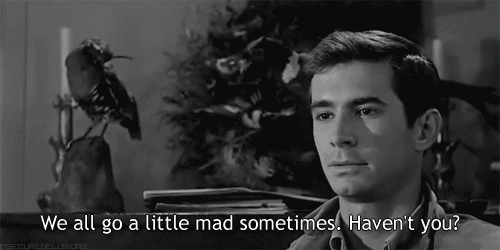
Take me as an example - I’m a cisgender woman.
Because I am not trans, I do not know what it is like to feel like I was born in the wrong body. It’s hard to understand how it is to be trans when one is not. However, just because I don’t fully understand it because I have not experienced it does not mean trans feelings, experiences, and rights do not matter.
To many, this lack of understanding - especially in past eras when being trans was labelled with far more outdated terms and concepts like ‘transvestites’ - can feel uncomfortable. This is what horror preys on.
You don’t always need a jumpscare to be afraid.
You don’t actually require a demonic nun to keep you from turning the lights out.
By simply being presented with something we don’t quite get, by just seeing something that doesn’t quite click in our brains, we are immediately made uncomfortable.
And that can make us afraid instinctively.
The only way to overcome this fear is, well, to face it! Ultimately, this can be reduced back to the lack of representation and awareness of trans issues and trans rights.
It’s time to talk about Insidious (2010).
Outdated tropes are just that - they are outdated.
They belong back in decades gone by. They no longer make sense in our society.
But the problem with the demonisation of trans women is that it is still shipped out via the big screen. And Ghostland is not the only offender.
Insidious will always be one of my favourite horror universes. And yet it was the first to show me how the horror genre is still propagating the same image of trans women.
One of the most iconic monsters in the franchise is that of Parker Crane, the spirit of a serial killer who was forced to adopt a female identity by his mother as a child. Her abusive actions result in him murdering innocent women while dressed as a woman.
Sure, Insidious pins his murderous actions less on their gender identity and more on the abusive actions of his mother, but the fact is it’s the same story of a man dressing up as a woman and killing women.
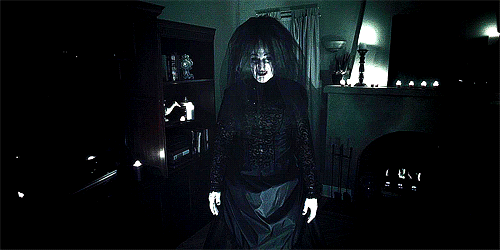
And even the finer details of The Bride in Black’s story are replicated in other movies tapping into the same trope.
Sleepaway Camp (1983) features a similar character to Parker Crane. At the twist ending, we realise that the serial killer is Angela, a supposedly innocent girl at the camp. How do we know this?
Because Angela is revealed to have a penis. And, of course, that means she has to be batshit crazy and a killer.
*eye roll*
Angela was assigned male at birth, and their abusive parents forced them to dress like a girl, just like Parker. But yet again we stumble into another damaging forced narrative that demonises trans women:
As they had a troubled childhood, they were trans. And as they were trans, they were thus a dangerous person.
The filmmakers drive this home further by the final image closing the film: all we see is their female face embodying clear mental instability and their male body. It is meant to be disturbing, it is meant to be shocking. Pull out the pencil, connect the dots, and here we are.
What we see is upsetting, and that means trans people must be, too.
She is yet another ‘bloke in a wig’.
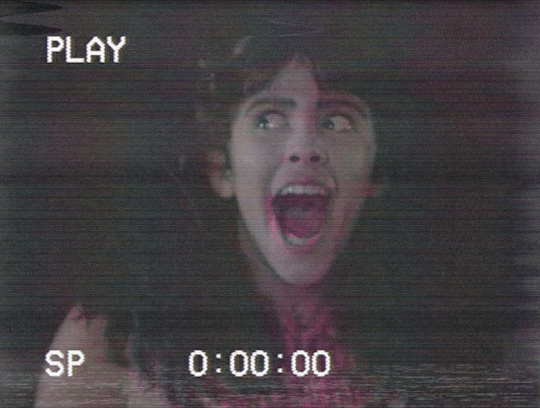
And if that wasn’t enough, Angela also provides us with the final segue into an LGBT-wide problem with the entire film industry.
(Mmhmm, it gets worse.)
Movie plot twists have always been praised, pulled apart, and memified via #edgy humour - they are the lifeblood of the film industry. And pumping through its veins is an eternal struggle to properly represent the LGBT community.
One of the ways that this occurs is that LGBT characters often feature as plot twists. They are there to shock us, to surprise us, to be the punchlines of the jokes.
Gay people are the shock twist when they turn down another character’s advances citing “they just don’t swing that way”. And trans people are the shock twist when they are revealed to be murders.
It’s a simple formula which ignores the fundamental complexity of humanity - and it’s this search for simplicity which stops the fight for equality in its tracks every time. We have to accept that people have experiences beyond our own, and these experiences are complicated and new and confusing and uncomfortable.
But they are real.
And they matter.
Only by addressing this complexity and listening to these real stories can we realise that it’s okay to be wrong and it’s okay to better ourselves via learning.
Okay, fine - so everything’s terrible.
Yes. And it gets worse.
Trans women in horror always follow the aesthetic presented by the concept of the monstrous-feminine, a concept erected by Barbara Creed:
Female monsters are abject beings that are a compilation of all the disgusting parts of being a woman.
You know, like periods and leg hair.

The films called out in this article follow this closely, but present this via extreme contrast between the male and female body. By confirming that they are abject and out-of-place beings, the trans women thus become the ready-made female horror monster - the alternative to the Final Girl.
They’re the Blair Witch, they’re the alien from Alien; but in some bittersweet way, they’re finally seen as the women they are.
However.
This portrayal isn’t exclusive to the horror genre. It’s not even restricted to the big screen.
Horror might have it wrong, but we can do our part to do things right. We need to learn, listen, and discuss how it really is to be trans.
Here are just 6 facts to start the conversation:
Trans women are not destined to be murderers. In fact, there is a day dedicated to those killed by transphobia - the Transgender Day of Remembrance (20th November).
A project dedicated to monitoring the murders of transgender people began in April 2009 due to the significance of transphobic-motivated violence (The Trans Murder Monitoring Project).
Last year was the second deadliest year for trans people on record (The Trans Murder Monitoring Project).
At least 48% of trans people fear using public toilets due to fear of discrimination and harassment (Huffington Post).
At least a third of trans students in higher education have received negative comments or experienced negative behaviour from staff in 2018 (Stonewall).
45% of trans people between the ages of 11 and 19 attempted to commit suicide in 2018 (Stonewall.)
In 2019, at least 26 transgender people were murder with some of the cases clearly inspired by anti-trans bias. Most of the victims were transgender women of colour. (This fact came from @macaronimarine)

If you’ve got a fact or you’ve got an experience to share, I’d love it if you could add it. And if you haven’t completely given up on the horror genre, why not follow this blog and join me for a weekly article on horror films and the paranormal?
I also post a new real ghost story everyday!
Got a ghost story to share? DM me to feature on my archive of real ghost stories.
#best horror films#trans#transgender#trans women#trans men#pride month#trans representation#representation in horror movies#horror movies#women in horror#pyscho#norman bates#ed gein#insidious#sleepaway camp#an incident in ghostland#ghostland#lgbt#lgbt representation#lgbt representation in horror#trans people#trans in horror#buffalo bill#silence of the lambs
7 notes
·
View notes
Text
Smokey brand Movie Reviews: For the Lolz
A couple of years aback, there was this movie that sparked a ton of controversy. We were fresh off the heels o f the most contentious election in years and the whole #Metoo movement was gaining steam. In this environment of female empowerment and Social Justice Whiteknighting, f*cking Assassination Nation drops. It immediately garners all of the controversy, from staunch, third wave feminists, complaining about how the women are portrayed in this narrative, to the neckbeard misogynist complaining about the same thing, but with the dudes. I thought it as all very ridiculous and just loved the commentary of the film overall. Unfortunately, Assassination only had a limited run here and i missed it in theaters. It’s been out on streaming for a while but this is the first opportunity I've had to actually sit down and take it all in.
The Good
This movie is absolutely stunning. It’s saturated in blown-out, neon pretension and i love every second of it. Look, when a film has a very particular visual aesthetic, i gravitate toward that. I'm a sucker for style that way. If you have a very specific look to your art, there's a great chance I'm going to fanboy over it. Assassination Nation has a fantastic look, man. I love the use of color in this thing, the way it become more and more surreal as the the film progresses. The aesthetic of this movie is as much a character as the actual actors themselves.
I love the soundtrack to this thing. It fits the tone of this movie perfectly. This sh*t is Heathers with an aggressive slathering of Millennial cynicism. Since I am a Millennial, this sh*t resonates hard with me and the chosen music just pounds that despondency home. In an an upbeat, everything-is-on-fire-but-this-is-fine, sort of way.
I adore the copious amounts of sardonic social commentary in this sh*t. The presentation is definitely over the top but, living in 2020, the sh*t in this film seems like it can happen next month. Its wild to think that, two years ago, this was a salacious, neurotic take, on the modern normal but now? Now this sh*t seems tame.
Look, this film is definitely style over substance but what f*cking style! This sh*t just gleams with glittery nihilism and an acute bubble gum tragedy. I’m a sucker for that juxtaposition and Assassination Nation executes that sh*t near perfectly. It’s one of the best examples I've ever seen anyway. I can’t praise the presentation of this movie enough. It truly is a glory to watch.
The action in this thing is kind of f*cking amazing. It takes a while for it to get going, but when it does, it’s f*cking outstanding. This sh*t is a call back to those old grindhouse features chick full of sex and violence. You don’t see that nowadays and, when you due, it’s a problem. Just like this thing was back when it dropped. The thing is, that stuff never felt gratuitous in this film. I think that sh*t was the point and serviced the plot to that end. I respect the production for going all in on that stuff knowing it would be detrimental to the finished product.
The message this film so gaudily, gorily, expounds upon us, the audience, is actually pretty profound. The hypocrisy of our social structure is called out in a giddily violent way. It can be delivered a pretty heavy hand at times, that entire climactic dialogue was a little on the nose, but it is absolutely something that needed to be said. It's something that needs to be discussed. It's an important conversation that needs to be ongoing and evolve as our understanding grows. Jut because the packaging of said message is pastel panic and barbie doll battery, should ever detract from it's validity.
The Bad
This f*cker is long and you feel it. I think there are a lot of cuts that could have been made to make this run time more palatable to the average movie goer. Those change were not made and you’re left with kind of a slog.
The characters in this movie are sh*t. I couldn’t tell you who one person was over another, just vague descriptions. I think that’s because the characters are actually vague caricatures of people. They fit cliches and tropes, not personalities of actual living, breathing, people. I think, though, that’s fine because this movie is more about the circumstance than the people caught in the circumstance. Still, it's kind of hard to identify with the characters in a film if they’re not written like people, you know?
This dialogue, man, it’s the worst. People don’t talk like this. This is how movie executives think teenagers speak to each other. It’s not real and it actually sounds like a script. I don’t know if this is because the performances all seem phoned in or if it was the actual writing but, either way, it’s ridiculous to hear.
There are no performances that stand out in this move. None. They’re all mediocre, which is disheartening. With this material, with this message, you could have really made something special. Instead, it’s all window dressing for the stylized film making and over-the-top violence.
The writing in this thing reads like bad fan fiction, emphasis on the bad. It is very apparent the the narrative wright is on the way this ton eats itself but the way the POV characters are portrayed is cartoonish and wildly superficial. The plot, itself, is paper thin but it doesn’t need to be as deep as, say, Portrait of a Lady on fire, when it’s little more than an orgy of fluorescent violence, debauched circumstance, and unrealistic circumstance.
The Verdict
Assassination Nation is entertaining. It’s by no means a great film, at all, but it is a pleasure to see. The stylized presentation and scathing commentary about the country's toxic relationship with technology, is more than enough to carry you through the plodding run time, non-performances, and paper thin characters. The writing can be difficult at times but the message is definitely one worth heeding. I didn’t hate this movie but i didn’t like it all that much either. It has something to say and it says it in the most violent way possible but, at the end of the day, i don’t understand why this thing was so controversial. I do think it’s worth a watch. Like i said, i was entertained even if it’s not that great of a film.

1 note
·
View note
Text
The Heroine with a Thousand Faces
As the youngest member of #TeamPurpleLion, not only have I learned a lot in just the four months we’ve been working together, but I’ve explained a lot of what I’ve learned to others. Sometimes it’s about the history of Defender of the Universe and Beast King GoLion that @crystal-rebellion researched, sometimes it’s referencing @felixazrael‘s musical knowhow or @leakinghate‘s animation knowledge, and most recently, it’s leaning on @voltronisruiningmylife‘s expertise in how to break down and identify writing to provide corrections to those who see something in a show or article not working but can’t tell why. One big thing I learned since starting this crazy ride with my team is a massive hole in my college education on writing, which Felix filled in for me since we hit the ground running. Sure in my fantasy literature class we discussed Aesop and The Hobbit, and what the phrase “The Hero’s Journey” means and why it’s the monomyth, but there was one thing that my dear professor never taught us, although I’m sure she will in the future. Compared to Joseph Campbell’s heroic journey, this other monomyth is much younger.
What is it, you may ask?
Simply put, it’s a heroine’s journey.

[Image description: Princess Allura with her hair up and wearing her flightsuit from season 1 “The Rise of Voltron” backlit by white light.]
Let’s go on an adventure together.
To understand the heroine’s journey, I want to give you all a rundown on what exactly the hero’s journey is first. While it was never neatly labeled as “The Hero’s Journey” until Campbell, studies on common themes and plot points began back in the 1870’s. As time moved forward, Campbell published his 17 steps to the monomyth in 1949 (The Hero with a Thousand Faces) and as we move toward the present his monomyth is eventually dubbed as “the hero’s journey”. I won’t overload you with the dates and stuff I needed to study since that’s a) not the point of this piece and b) Campbell’s monomyth is actually secondary to the main one in Voltron: Legendary Defender. That said, it’s the backbone of a lot of literature both old and new, and while not every story follows these 17 steps outlined by Campbell or approaches them in the same order, you’ll find everything from the story of Christ to Lord of the Rings somewhere in these steps. It’s just that a lot of times the steps of the hero’s journey aren’t ever really explained, so you as a reader/viewer/consumer will see them and will have a gut instinct as to what’s supposed to happen, and when it happens you feel great! The story followed a formula that satisfies its audience! But it also makes a story that doesn’t follow a formula feel fundamentally wrong, from just a mild discomfort like putting on a shirt and buttoning it slightly off, all the way to triggering strong emotional responses including panic attacks or tears. Stories are designed to bring forth emotions from their audience, but what good is a tragedy without a lesson to learn? How can we enjoy an empty marriage when the couple has no chemistry?
So with this piece, I hope to illuminate just what the steps of the heroine’s journey are, contrast them against the hero’s journey, where VLD fits into all of this, and through that demonstrate why they are not interchangeable even though they share similar names.
Part I: Of Heroes and Heroines
In The Hero With a Thousand Faces, Joseph Campbell outlines seventeen steps, which are laid out in this diagram by Reg Harris:
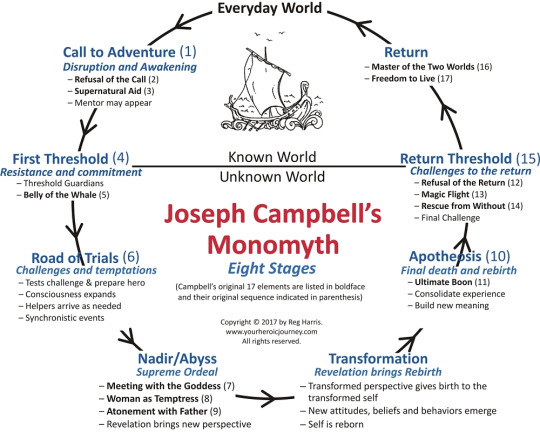
[Image description: diagram of The Hero’s Journey using a circular diagram shape separating out the seventeen steps into eight categories, divided into the Known World and the Unknown World.]
In Maureen Murdock’s The Heroine’s Journey, she writes the heroine’s journey as follows:

[Image description: The Heroine’s Journey depicting a cyclical diagram of the narrative, featuring 10 distinct steps that loop back to the beginning at the top.]
The Heroine’s Journey is fundamentally cyclical in nature, and while the diagram above shows the Hero’s Journey as a circle as well, it ultimately has finite start and end points. One of the key differences between these is that the Hero’s Journey explores internal character in an external adventure and the hero achieves a (theoretically) lasting peace once their journey is finished. Conversely, the heroine must constantly evaluate themselves in the bigoted environment that tries to disenfranchise them.
As a note, while I use gendered terms such as “hero” and “heroine”, I use them as gender-neutral placeholders to label which monomyth I’m speaking about at present. Women can undertake a hero’s journey, and men can undertake a heroine’s journey, particularly when you examine them in an intersectional lens.
A heroine’s journey, at its heart, is an examination and acceptance of the self in an unaccepting environment, and its cyclical nature stems from the fact that whenever a heroine moves into a new environment, they have to make that journey over and over. They can be a queer man of color, a white stay-at-home mom, a disabled nonbinary person, whatever the case, the constant need to re-evaluate their place in the world is what marks the heroine’s journey as separate from the hero’s journey.
But while it’s cyclical in nature, we should start at the beginning nonetheless.

[Image description: Alfor (right) holding Allura (left) in the Castle of Lions. She says, “We can’t give up hope!” and he replies, “I’m sorry, daughter.”]
In The Heroine’s Journey, the story begins when an event causes the heroine to separate from the feminine. A significant event spurs them to reject the prescribed role of the patriarchy, which in the case of a woman could be a mother, a damsel in distress, a wife, etc. The heroine is put into a box and chafes against its edges because it cuts them off from their ability to reach for the masculine, the power and privilege it affords. This marks a stark difference from how our archetypal hero lives and begins their own adventure. The hero lives a fairly mundane life for the brief time we see them before the first element comes into play: the Call to Adventure. This is generally an external force spurring the hero to action, as opposed to the internal force of the heroine.
The hero then will Refuse the Call and will be introduced to the Mentor they will come to rely upon, whereas the heroine typically immediately begins on a journey to become more powerful/masculine, generally through rejecting femininity. Princess Allura does not inherently reject her own femininity. She rejects the helplessness of being forced into cryostasis after her people have been destroyed and embarks on embracing her masculinity by finishing the war her father and Zarkon started 10,000 years ago. The heroine Identifies with the Masculine and Gathers Allies, which we see Allura do in the pilot of season 1 of VLD. She awakens to find a team of five men and her male adviser Coran, her allies in the coming intergalactic war, and she takes up the metaphorical lion herself as the pilot to the Castle of Lions, changing into her armor--pink, to honor the fallen--for the fight against Sendak as he tries to claim the Lions of Voltron for Emperor Zarkon. Her choice of pink, particularly pale pink, is reminiscent of the breast cancer awareness ribbon, baby pink, it is an intrinsically female color that she dons to assume the role of her father, King Alfor. The narrative is reminding the audience that Princess Allura--the first nonwhite Allura, no less--is just as much a princess as her previous white and blonde iterations are warriors.
After choosing their allies and undertaking this quest of gaining power (not to be confused with empowerment, our heroine is still operating within the confines of the patriarchy here), our heroine undergoes trials and faces enemies that try to persuade them back into the box, into what’s known and fundamentally safe and silencing. The words may be kind, be delivered kindly, but ultimately they can be boiled down to a single message: “go back to where you belong.” For the hero this is a point of no return as an external journey. The hero can choose to go home and leave saving the world to someone else, or they can choose to face the trials that bar them from their prize. But the heroine? They can’t. There is nobody who can save the heroine’s world because for them because their world is what they are trying to escape, and often they are the prize for a hero. It’s up to them to save themselves, and at this point in time, adopting the masculine and the power of the father figure is the way to go. And it works. Princess Allura, again while she does not get discouraged by the men around her to remain an idle princess, because this is the 21st goddamn century, her conflict arises from inexperience. King Alfor supports her drive to finish the war and take decisive action, to finish what he started. The Paladins challenge her authority as a sovereign in the beginning because even if she’s a princess by birth, she has no planet and they’re not of her planet or species anyway, and until they themselves undergo trials in the first few episodes do they appreciate that Allura is still critical as a person, despite her lack of sovereign weight.
Together, she and her team move through the obstacles and the war against Zarkon together, while simultaneously trying to build a coalition of allies to aid in the fight. In fact, much of the plot of VLD takes place during this stage of the heroine’s journey, and it’s here where we as the audience follow Allura as she meets her animus in the form of a Shadow figure: the cunning Prince Lotor. He takes on the role of the challenger to force Allura to better herself, and as Allura rises to the occasion each time, he is textually impressed by her battle skill, then by her intellect. The most iconic moment of Lotor as a Shadow (aka: the half of herself that Allura doesn’t want to accept yet), is when he baits Voltron into battle, then pilots his cruiser through the volatile environment of Thayserix. He expresses disappointment at Voltron’s ability in battle, but when Allura in Blue rises to meet the challenge he lays out, he praises her, even if he textually does not realize who is in Blue at the time.
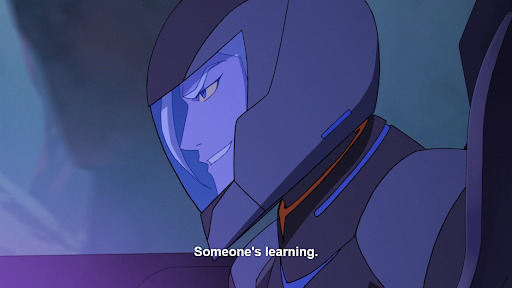
[Image description: Prince Lotor in profile, a pleased expression on his face, and the subtitles read “Someone’s learning.”]
As a brief aside: the animus comes from Jung and is often paired with an anima, or masculine and feminine energies. The key takeaway is that these energies are complementary to each other and exist in a balance. While they typically are portrayed in a more heterosexual context, like everything else in this meta, the terms are used in a gender-neutral context when not applied directly to Allura’s storyline. While Lotor could be likened to either Meeting the Goddess or (Wo)Man as Temptress in the hero’s journey, a key difference between the heroine’s journey animus and either of these feminized roles is that the Goddess and Temptress are two separate figures--generally women to male heroes--and are generally not equal to the hero physically or mentally. The animus, however, is intrinsically the perfect match to the anima of the heroine, being their complement and their intellectual and physical equal. Lotor is not meant to be seen as the woman on Indiana Jones’ arm, he’s meant to be a force in his own right, challenging Allura to better herself and raise the standards for them both. It’s fitting that this occurs in an episode full of fog and a dangerous abyss, because the traditional hero descends into a metaphorical (or literal) one to encounter these flattened versions of feminine energy.
The trials continue for Allura through the seasons, and she makes many allies and continues to face their enemies head-on, and once Prince Lotor, now Emperor, cements his place as one of Allura’s allies he shifts from the Shadow figure challenging her to the animus in full, being encouraging and supportive as they work together as allies to find Oriande, a mythical place that should yield them the secrets of unlimited Quintessence. While Lotor challenges Allura in a traditionally masculine way (physical trials, battle, strategy), he also encourages her in a decidedly feminine way through Altean history and mythology, as Altea is very feminine-coded compared to the Galra Empire, which through Zarkon represents a familiar and violent strain of masculinity that seeks to crush Allura and force the universe to fit his will through abusive language and physical violence and genocide. Allura taking up the battle in Alfor’s place is simply her continuing the cycle and seeing power in masculine terms, rather than breaking the cycle.
Now here is where the diagrams diverge even further. Until this point, the journeys followed fairly similar trajectories. After the trials and battles of the heroine’s journey, they experience the boon of the journey, which the hero does not achieve until they face further trials and temptations. As such, we will continue to follow the heroine’s journey model and I’ll explain the significance of the flip.
Part II: Not the Place to Arrive
One of the significant things about the heroine’s journey is that when a woman undertakes it, it’s empowering and her becoming her most unified self. Campbell once reportedly said to Murdock, “Women don’t need to make the journey. In the whole mythological journey, the woman is there. All she has to do is realize that she’s the place that people are trying to get to.” In the hero’s journey, often a woman’s place is as the prize, rarely is she her own agent. As I stated previously, the hero and heroine journeys do not have to ascribe to gendered protagonists, however the reality is that the hero’s journey is very patriarchal in nature since it was formulated primarily through the study of male heroes and does not take into account the constant reassessment heroines must face. For heroes, they simply must survive going from point A to point B. Heroines are always subjected to reevaluation within their environment and the people around them, so their journey never really ends.
All this is to say that the hero receives their boon at the end of their story and that’s the end of it. They get a happily ever after and can return to normal life and spread their bounty to those in need or dearest to them.
The heroines?
They get their boon at the middle of the story.
And there’s still more to come for our heroine as they build toward the climax (pun intended).
Princess Allura receives the boon of Oriande’s secrets with Lotor by her side, which in pretty much every literature class would become a discussion on the ways this represents sex, or the the ways Allura is interacting with the world in terms of gender, particularly how they discover Oriande after having an emotional reaction in Haggar’s lab and activating the Altean compass stone. In the heroine’s journey, this boon is often of the same significance as the hero’s boon/reward at the end of their journey, but for the heroine it’s false. It’s fleeting. It’s not meant to last. This is the turning point for our heroine because while yes, our heroine achieved the goal of the adventure, they did so by consciously or unconsciously shunning the feminine. In Allura’s case, she’s still taking after her father, trying to follow in his--and to an extent Zarkon’s--footsteps by mastering the unlimited Quintessence.
And true to form, before season 6 is out, our heroine seems to be betrayed by her animus, returning him to the status of Shadow figure as he challenges her to unleash the power within one final time. Princess Allura thinks Lotor lied to her and has been harvesting Alteans for their Quintessence when Keith and his mother Krolia discover a living Altean in the Quantum Abyss, and with the budding on-screen romance between Allura and Lotor, this betrayal cuts our heroine deep. To her, he not only lied about there being no more Alteans left, but he actively continued the genocide his father began 10,000 years ago. That’s not an easy thing to get over. So Lotor assembles Sincline, which bears a visual resemblance to a wingless dragon--the last metaphorical dragon she faces before moving into the next step of the heroine’s journey--and with Allura in Voltron the two battle it out in a tragic action-packed scene that leads to Voltron overloading Lotor with Quintessence and leaving him in the Rift.
With the dragon defeated and the boon lost, the heroine has to sacrifice not only her animus, but the last vestiges of her home to try and undo what following the masculine has done: close not only the original Rift, but all the fractures in reality caused by their battle.
And what does a girl who has already lost her planet, people, and lover have left to lose?
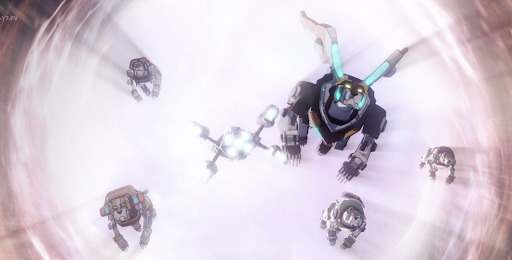
[Image description: The five Lions of Voltron flying away from the massive Rift, the Castle of Lions flying straight toward the center of it.]
The heroine following the footsteps of the masculine always comes at a major cost to them. In Allura’s case, she has to sacrifice her castle in order to make right the harm done to the literal universe. In this case, she mirrors Zarkon in his destruction of the universe, but rather than directly harming billions of lives on uncounted planets, she creates a literal hole in the universe because of her blindness to the consequences of the actions of herself and those around her.
And much like her father sending away the Lions, she must send away her castle in the hopes of saving the universe from greater destruction.
Part III: Transcending the Rift
From the gain and loss of the boon, things look dire for the heroine at this stage in the journey. In Allura’s case, she is without people, without planet, without castle, and as she learns at the beginning of season 8, her found family has families of their own--other than Coran, that is. Our heroine continues to lose pieces of the things and people surrounding her at the beginning of the story: which Murdock refers to as awakening feelings of spiritual aridity or death. She is losing her place in the universe even faster than before, when she stood on the shoulders of her father, and she must move forward. Allura passed the point of no return all the way back in season 1 episode 1. As the heroine, she broke free of the safe mold she knew for the past 10,000 years, and every episode since her awakening she has had to try to forge forward on the path she knew: that of her father. Now, though, her father’s methods have failed her, just as they failed him, leaving her with no option but to keep moving forward and to approach her journey from another angle.

[Image description: from left to right, Veronica, Allura, Romelle, and Pidge (mostly off-screen) in a clothing swap shop as Allura speaks. Caption reads, “I could give you a royal decree of service from the Crown Princess of Alte…”]
Allura not only must deal with the loss of her place in the universe, but she must also deal with the fact that by leaving Lotor in the Rift, she abandons half of herself as well. Physically she is a whole person, but if we look at her role as an anima and what her fears and strengths are, destroying her animus throws her self-knowledge out of alignment. She’s careening away from the safe path of her father, but she must now rediscover the strengths within herself without succumbing to her weaknesses and do so by stepping out of her father’s shadow.
Season 8 is rife with emotional buildup and no payoff. We as the audience don’t know what happened to Lotor for the whole of season 7 and we see Allura struggling to deal with all her losses, we travel to Earth and meet the MFE pilots, a plucky bunch who probably were meant to lay groundwork for a new Vehicle Voltron, and we see that Haggar/Honerva is the final big bad of the whole show, ready to vindicate the son she lost to the Rift, but also 10,000 years ago when he was born and she became the Witch we love to hate. So when we join Allura and the gang on Earth with Luca in the infirmary, and Allura’s final trials begin…
Or they should have.
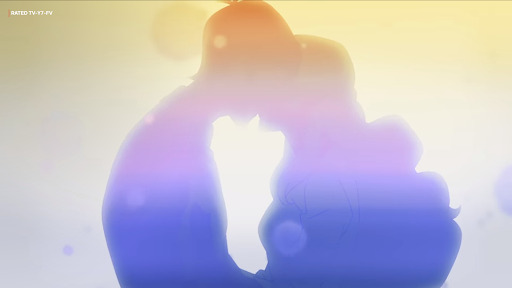
[Image description: Lance and Allura kissing in rainbow lighting where they are artificially-colored in red, then pink, then blue from top to bottom in front of a fading background of warm yellow at the top to gray at the bottom.]
Instead, we are treated to the final acts of a hero’s journey, but still following our heroine through the steps.
Our heroine wears down to the persistence of Lance, who in a heroic journey would receive a fair princess as his boon, and Allura is trying to find a place to belong. In seasons prior to this, Lance acts like a goofy everyday guy, very much a typical character in many present-day stories that allows the audience to see themselves in him. He fantasizes about wooing the princess, calls himself a ladies’ man, tries to be funny, he’s a pretty typical character that a male audience is more likely to sympathize with, and as such the fantasy is pairing up with the prettiest, smartest, etc. girl in the story. The woman as a boon, the Goddess, and the Temptress are never on equal footing with the male hero, and even in the case of female heroes, the meeting with a god(dess) means that the female hero is worthy of being a consort rather than the equal that a heroine is to the anima/animus. In fact, Campbell reportedly told Murdock, “Women don’t need to make the journey. In the whole mythological journey, the woman is there. All she has to do is realize that she’s the place that people are trying to get to.” In the hero’s journey, if the hero is male and heterosexual, the women will always be the prize, the virginal ideal, or the sexualized damnation, and in all of them, the woman is meant to be receptive to the man (and doesn’t THAT sound like some familiar rhetoric). Never is the woman an agent in the hero’s journey when it fulfills a male fantasy. And it is this very same box that spurs a heroine to begin their heroine’s journey: this breakdown of people to individual parts as determined by a patriarchal society.
While Lance is a hero in his own right, in Allura’s heroine journey, he acts as an ogre that comes dressed as a male ally all the way back in season 1. He’s a Subverted Nice Guy in that he’s constantly trying to woo Allura, but ultimately he’s still reinforcing the same patriarchy that not only plagues Allura in this iteration, but also in previous iterations of the Voltron franchise. The Nice Guy doesn’t challenge the heroine like the animus, but rather encourages them to stay in place or to fit a predetermined mold once more.
Look familiar?

[Image description: Lance’s fantasy, with him standing triumphant over Zarkon as the team cheers him on, Allura kneeling at his right side and looking up at him, while a flag with his face waves on his left.]
Many of the silly shots in the series have been foreshadowing, whether in the most direct sense or in the promise of subverting what’s portrayed. In the case of this screenshot, by the time Lance gets the girl, Zarkon is killed (by Lotor), Allura has already had an intimate relationship (with Lotor), and the team collectively became heroes and allies of Lotor before the end of season 6 happened. Lance, textually, is not Allura’s equal as an animus, and while he doesn’t quite view her as his equal--especially in earlier seasons--he can only textually become her equal when she is at her lowest point, and he’s still affixed to the idea that she’s a prize, going so far as to say that “winning prizes is my specialty” in “Clear Day”. Really, it’s a messy relationship dynamic that tries to show the audience why, as they stand in the canon material, they don’t work. Not only is Allura still not his equal, but his fantasy comes about at the hands of others, or with the help of others, and he comes second. He plays a role, but he is not the singular hero he once fantasized about being. Textually this subversion is teaching him a lesson about becoming his best self and acknowledging that he doesn’t have to be the hero, the payoff of which should have come in season 8 as Allura completes her heroine’s journey to become her most unified and realized self. It’s meant to be his apotheosis, the new perspective and enlightenment brought to the hero after facing all the trials of the journey as a part of the final reward.
Allura, fighting with this sudden loss of herself, must now also help spearhead the war against Honerva, the archetypal Bad Mother, in an alchemist-versus-alchemist battle for not only Lotor’s physical soul but for Allura’s metaphorical one as well. This is a new fight, the gauntlet thrown by someone other than her animus, and after all his tests, she must still rise to the challenge with the same energy, but she must do so with new knowledge now that she knows she cannot rely solely on her father.
But what’s the next step for a heroine trapped in the arid desert of the unknown self and with the weight of the world pressing onto them?
They must descend to the underworld and begin the transformation from the masculine methods to unleash the femininity that’s been locked away this whole time.
And who do we have to escort Allura to the metaphorical underworld as she falls asleep?

[Image description: A close-up of Lotor’s face in deep shadows as he stares head-on at the “camera”.]
Her Animus, acting as a Shadow once more.
His entrance is littered with sex. Not literally, but metaphorically. He greets Allura while she’s in bed, the camera does a gratuitous slow pan over his body in a way that many cameras exclusively afford to women, the presence of a blooming flower with an erect stamen, the lighting of the preview--altered in the final season itself--is purple even, a romantic and spiritual color. You know the joke in college English classes about how everything is sex except sex? That’s this scene in a nutshell. He’s always been drawn and behaved in a way designed to appeal to the female gaze (an essay in itself), but this scene really takes the cake.

[Image description: Lotor as viewed in profile from a low angle in a Garrison room, looking down at a juniberry flower in a pot.]
And it’s this scene where we see Lotor give Allura the first critical piece of information for how she can stop Honerva/Haggar, but also reminding her that some people do not change. While Allura must change to achieve her realization, he reminds her that Haggar is still the same witch, and that her pain of losing Lotor becoming public does not excuse the fact that she has not expressed remorse or tried to change herself, let alone her hand in not only his downfall but in the brainwashing of the Alteans. She is an antagonist so focused on the wrongs done to her that she justifies the wrongs she does to others with them. Allura, however, expressed remorse and wanted to save Lotor as soon as she realized what was going on, which further cements the ways in which their fates could have been the same or switched had they made slightly different choices. Honerva is 10,000 years too late. Like Lotor mirrors his father and in “Shadows” is shown to be more empathetic, Allura mirrors Honerva and both prove throughout the show to have stronger moral compasses than their predecessors. They are the Emperor and Alchemist, and while fate decrees they must take up the mantle left behind, their free will dictates that they should not blindly follow their footsteps if they truly wish to make a lasting change. Narratively, they must forge a new path if they are to bring the universe to peace again.

[Image description: A close-up shot of the juniberry flower with Allura visible in the background, but blurred. The subtitle reads Lotor’s line, “The witch may change her name, but she will always be a witch.”]
Lotor tempts Allura to take the entity into herself, and when she reaches out to connect with it, she is taken further into the dreamscape and finds herself back on Altea and greeted by her mother. This marks the beginning of the reconnection with the feminine, but while Allura has always so desperately missed her family and Altea, she finds herself in a precarious position. Suddenly, she is in the very same mech suit that Luca was found in, and to save Altea from the Galra fleet overhead, she makes the decision to use the planet’s Quintessence. However, in the process of destroying the Galra fleet, destroys Altea as well. As her world crumbles, her mother congratulates her for a job well done. This presumably mirrors the dropped plot about the Altean Colony and the decisions Lotor would have been faced with, and after “Shadows” would lend both Allura and the audience a greater appreciation for the position he was in before he died.
And when she finally wakes?

[Image description: Allura sitting up in the Garrison bunk, looking at the mice, the juniberry dry and wilted in the foreground, blurry. The subtitle reads, “It was only a dream.”]
Our oh so sexual symbol is wilted, and Allura wakes up alone.
With the visual deflowering and this new revelation about the kinds of decisions those before her have had to make, Allura can begin reconnecting with the feminine in earnest without falling into the old placements she may have been subjected to at the beginning of the story. This would have continued further with Allura reconnecting with her animus in the missing episode @leakinghate titles “The Descent”, especially fitting as she continues her descent to her feminine roots as a heroine and to reconnect with her lost animus. Reconnecting and reconciling with him--and with the side of herself he represents--is critical to her achieving unity within herself and being able to face Honerva head-on.
Once the heroine has descended to the underworld, begun the reconnection to the feminine, and returned with new knowledge on their relationship to their emotional side and the aspects overshadowed by the masculine, they are ready to begin healing the mother/daughter split. This in essence is the heroine returning to the old knowledge she has cast aside when following the path of the masculine/father, but approaching it with a new understanding and perspective. Think of it as understanding why your parents enforced rules like “don’t run into traffic”. As a kid, the danger may not be obvious, but as an adult you’re able to look at the same situation, see over obstacles younger you might not have, and realize “oh shit, that’s a car”. That said, the heroine does not allow themselves to get put back into the same or even a different pre-prescribed role because they now have a greater understanding of the situation at hand.
In Allura’s case, this means revisiting the plan on how to take down Honerva, and realizing that she must pursue the course laid out by her trip to the underworld to not only save the universe, but awaken Lotor from being a robeast. Part of the conflict against this plan comes from the team, who see the entity she took within herself as dangerous. While that’s true, stopping the plan also prevents Allura from growing in strength to be able to fight Honerva. The power flowing within her that Lotor referred to back in season 6 is at her fingertips, and like his visit in “Clear Day” reminded her, she need only take it. During both parts of the “Knights of Light” episodes, Allura is confronted with shades of Honerva’s memories as they dive deeper, and it’s here that we as the audience and the cast are meant to learn what truly became of Lotor after he was imprisoned in the Rift, and it’s meant to be utterly jarring to everyone. Instead, with how the scenes were edited together during the post-production alterations, Hate aptly points out in “Seek Truth in Darkness” that Honerva promising vengeance and seeing Lotor’s corpse has next to no impact. Or rather, it does to the audience--a melted corpse isn’t exactly Y-7 appropriate--but the characters don’t really react to this revelation at all.
That said, it’s more than likely that Allura genuinely believes Lotor to be dead (as opposed to a sleeping prince), which would explain her aggressive reaction to seeing pre-Rift Zarkon, and we don’t see his reaction to learning what he did to his son, either. This would be a prime location for Zarkon to experience and express remorse for what his actions have done to his son, subverting the toxic masculinity narrative his character had been representing prior.
At the end of “Knights of Light Part 2”, Hate mentions that Allura would need to make another trip to the underworld to commune with Lotor and realize that no, he’s not dead, but also that she not only must defeat Honerva, she must do so in order to save Lotor and free everyone of the cycle of violence that began 10,000 years ago. This is the final descent she makes before she can heal the wounded masculine, both in herself, and Lotor directly.
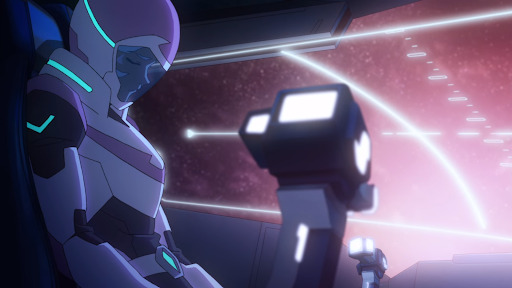
[Image description: Allura in profile inside the cockpit of Blue Lion, unconscious. Her window displays measurement increments and stars in red-tones, while Allura herself is lit in blue tones.]
After the end of this episode, however, Hate mentions that much of what was there is butchered in the post-production editing, so I will be extrapolating based on the content we have in the season as well as utilizing her analysis of the story as it should have been.
When Allura wakes up from falling unconscious, this is when we should see her proposing to save her animus, and it should come with a discussion with Lance about how they don’t click romantically. That said, in the version on Netflix, we see their relationship continue, however much of their shared body language doesn’t necessarily even match up with an awkward couple. Lance seems sullen and possessive, and while he might still be sullen in Allura’s original heroine’s journey, he would have had this moment of growth in which he learns to let go of Allura. She’s his fantasy, and not only is that unfair to Allura, it’s also unfair to him, and he doesn’t need to be the hero or the guy that gets the girl. He can be himself, silly, sharpshooting, video game-playing Lance. A genuinely nice dude, which completes the subversion of the Nice Guy trope his character embodied for so long.
“Uncharted Regions” is a hot mess of an episode in terms of narrative flow and consistency, but this would have marked the beginning of the alchemist vs. alchemist fight for not only Lotor’s soul, but the universe. Honerva uses the Sincline mech and her new mech to start tearing holes through realities, and once Allura jumps into the fray, that moves the audience into the next missing episode proposed by Hate: “Storming the Pyramid”. This would be where Honerva uses Allura to revive Lotor because she did not receive the life-givers’ blessing, and Allura would do it, literally healing the wounded masculine, but also falling right into Honerva’s trap in the process. This would almost certainly be a highly-controversial thing among Allura’s allies, but like Allura remaining on the path she knew, it’s easier to accept Lotor as pure evil who got what he deserved, when at no point is there a definite case against him. In fact, “Shadows” is designed to render him as a sympathetic character, and seeing his melted corpse is even more horrifying after seeing him as a baby and child. But that’s the way it is when a heroine breaks the mold. The heroine defines their own role, and as part of that, it gives them the ability to help others break theirs. The heroine experiences true empowerment by divorcing themselves from the power structures that defined them before, and doing so with the greater knowledge of their internal masculinity and femininity. Allura revisiting the war of her father with the lifegivers’ knowledge to compound her intrinsic alchemical abilities is the moment when she achieves union within herself, and it manifests physically as reviving Lotor, her animus.
It’s after this point that we see the Purple Lion and Purple Paladin manifest, our namesake.
In “Day 47”, Kolivan references the team sizes the Blades of Marmora use. He references four and five as the usual sizes, but six occasionally happening, but what he says next is particularly interesting.

[Image description: Kolivan being filmed for an interview, saying, “Seven seems rare, but… it could happen.”]
The Voltron team had four Paladins briefly after Shiro disappeared and before Allura took up the mantle, but the full team always has five. After Shiro returned for good, their team became six Paladins.
Now, with the healed animus Lotor on their side, they could have the rare seven-person configuration that Hate discusses at length in “Seek Truth in Darkness”.
With the anima and animus aligned together at last with no secrets, they can unify externally the same way Allura unified internally, and battle against Honerva properly. Now, Team V, Lotor, and the entire universe can face Honerva head-on and stand a chance at winning.
We also should get the emotional payoff for Lotor as an abuse victim in his own arc, closing up this nice little loose end that hurts way more than it did before season 8 dropped.

[Image description: An up-close shot of Lotor glaring into the “camera” in green lighting and saying to Haggar, “maybe I will take pity on you when the time comes.”]
And it’s worth mentioning that while the final battle is exciting and action-packed, the final surrender of Honerva comes quietly, in the rift of all realities. The characters of Team V are able to deliver their character-based arc lessons, it’s a somber moment of learning as Allura, using once more the blessing of the lifegivers, enlightens Honerva to her memories and what she’s done, but also restoring her sense of self the way Allura was. This is the final healing of the mother/daughter split, and it’s significant that Honerva’s abuse victim not be her healer. Not only does Lotor (as far as we know) lack the ability, but it’s never the victim’s job to heal their abuser, just as it’s not the obligation of the oppressed to appease their oppressor. Honerva can finally move on and begin atoning for what she did by setting the ghosts of the Paladins of old in her mind free, but that still begs the question of what our heroine and her animus must do to finish the job.
This is where Lotor would get his second chance, in the most literal sense of the term, where he faces a similar trial to the one in Oriande back in season 6 and the burning question for a man so concerned with survival and cunning.
Is there something he would give up the life he has known and fought so hard to keep for?
And this time, the answer is yes.
Allura.
It was always Allura.
While Honerva is able to stop the rift from expanding by, well, not expanding it herself, she lacks the ability to properly close it the way that it was closed the first time. It takes one final adventure, one final unification by the anima and animus, by the heroine and her Shadow, and one final goodbye. Allura and Lotor, born of an age long past, become the lifegivers eternal through staying behind to close the rift.
The lionhearted goddess of life and her stalwart champion of survival.
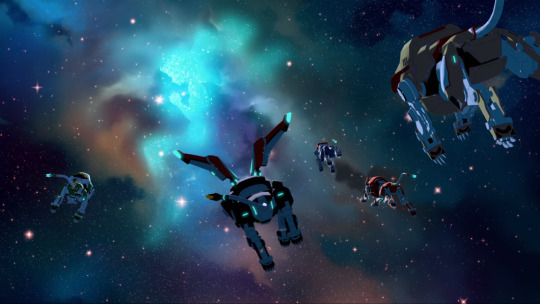
[Image description: The final scene after the credits, where an Allura-shaped nebula is nestled up against a smudged, darker nebula with a sea of stars among them, and the five Lions of Voltron flying toward the nebulae.]
Sources
Dos Santos, Joaquim and Montgomery, Lauren. Voltron: Legendary Defender. Netflix. 2016-2018.
LeakingHate. “Seek Truth in Darkness”. VLD Visuals Detective and Imperial ApologistTM. 2 Mar. 2019. https://leakinghate.tumblr.com/post/183160042843/seek-truth-in-darkness
“Maureen Murdock’s Heroine’s Journey Arc”. The Heroine Journeys Project. https://heroinejourneys.com/heroines-journey/
Murdock, Maureen. The Heroine’s Journey. 1990.
University of Kansas. “Science Fiction Writers Workshop: Joseph Campbell’s Hero’s Journey”. KU Guinn Center for the Study of Science Fiction. http://www.sfcenter.ku.edu/Workshop-stuff/Joseph-Campbell-Hero-Journey.htm
#dragon's ramblings#TeamPurpleLion#vld#the heroine's journey#voltron#allura#lotor#writing#literary analysis#strafe#hero's journey#lance#executive meddling#freevlds8#free vld s8
116 notes
·
View notes
Photo

I Shot Andy Warhol (1996) is a dynamic, true crime, avante garde film that explores the history and complexity of the relationship between famous artist Andy Warhol and radical feminist Valerie Solonas. The true events depicted in this film are told through a mixture of narratives that both highlight the socio-political climate of the 1960s and the struggle for female identifying empowerment. I thought it was particularly interesting that the film was first intended to be a documentary about Valerie Solonas, but the filmmakers could not find enough footage of her, nor any individuals to speak about her. Throughout the film, the various narrative perspectives mirror a documentary styled memoir. Mary Harron tells Valerie’s narrative using a combination of flashback narratives, self recorded home videos of ‘Valerie’ reading from her own Manifesto as it pertains to the current storyline, and an unnamed character reading Valerie’s file referring to her as ‘the patient’. The last narrative technique allows the viewers to gain some context surrounding both Valerie’s intentions and behaviors. The unnamed narrator discloses Valerie’s history with being molested, prostitution, homosexual activity, and ultimately her belief in ‘the natural superiortiy of women over men’. These biographical narratives ultimately illustrate a much bigger picture than just the relationship between the two. . The key themes highlighted in I Shot Andy Warhol include superiority, ironic male validation, radical feminism + matriarchy, mental illness, revolution, lesbianism, and revenge. . Valerie’s detrimental motives as a protagonist in this film are driven by her attitudes toward female superiority over men. Valerie’s constant push to educate the masses on her S.C.U.M Manifesto (Society for Cutting Up Men) is bound by the idea that women are biologically superior. Within this superiority complex is a duality of anti-man rhetoric, paired with using men for her advantage when she needs to. I found it ironic that while Valerie is so anti man, a recurrent theme in the film is the chase for male validation; especially Andy. From the first time Andy Warhol’s name is mentioned in the film, Valerie is desperate to get Andy’s attention in hopes that his connections and artistry will help her spread her radical views through media. Valerie constantly pushes her beliefs onto Andy and even gives him the only other copy she has of her screenplay for him to read. Even after begging Andy to read it, he dodges Valerie’s push for production but still holds onto her beloved copy. This stands as a symbol of Andy still holding a piece of ownership over her but refusing to give her the validation she is chasing. As mentioned in the original report, Valerie’s erratic behavior and radical beliefs stem from a comorbidity of mental illness, likely OCD and Schizophrenia. It is revealed at the end that Valerie is sent to a ‘Hospital for the Criminally Insane’ following the shooting. While it is unclear to the audience whether or not Valerie realizes her diagnosis, Valerie’s mental health is obvious to the other characters. Valerie sees herself as a revolutionary, while others (specifically men) consistently label Valerie as a ‘lunatic’ and insane for her beliefs. There is a wide gap in perspective from Valerie’s view of herself versus other’s interpretation of her. . The cinematic aspects of the film were what captivated me the most while watching. One recurrent technique throughout the film was the specific and deliberate use of the color red, red lighting in particular. The first time Valerie visits The Factory trying to find Andy, the lighting surrounding her is a shadowy, transparent red glimmer focused on her face. When Valerie goes to meet with the publisher to sign her book contract, she specifically picks out and wears a red dress. After being ‘excommunicated’ from Andy and his group and going to confront him, there is dark red light surrounding the group as they walk out of a tunnel. However, when Valerie’s face enters the frame to speak to Andy, the red light behind the group disappears and the light shown on Valerie’s face is harsh and bright white. The repetitive incorporation of the color red stands in as a symbol for many emotions and moods, such as: embarrassment, frustration, humiliation, bloodlust, romance, need for validation, and superiority. . The visual techniques during the party scene at The Factory were especially noticeable. The bright, saturated, revolving and color changing lights stood to amplify the mood of the party for those in attendance. The mixture of light movement paired with diverse colors and patterns added a layer of intoxication to the scene and reflected how the party-goers were feeling under the influence. . I think the most important cinematic aspect in this film were the deliberate mirroring shots to tell different aspects of the same narrative. During the scene of the party at The Factory, both Andy and Valerie are surrounded by people but standing alone. They both slowly look up and make eye contact with one another from across the room as the camera pans in on each individual. The last scene of the film depicts Andy standing in a crowd surrounded by others, when he hears a popping sound reminiscent of a gunshot. This triggers Andy to turn around as he sees Valerie standing alone directly across the street. The two once again make eye contact, and in the same angle as before, the camera pans into both individuals’ reactions. Andy stares nervously and Valerie disappears after a car passes by. While both shots mirror one another in technique, the emotion and context behind both are drastically different. The first implicates admiration and need for validation, while the final shot indicates fear from Andy and accomplishment from Valerie. . Many aspects of the film are reflective of the time period being portrayed in the film. As mentioned in the original report, this film took place during the Vietnam War in the 1960s, where the socio-political climate was extremely volatile and filled with protest and anti-government and anti-war sentiments. While I do not think anti-war attitudes were presented at the forefront of this film, or even mentioned more than once, I do think that Valerie’s passionate and revolutionary motives were inspired from the political climate during this time period. . The set design and costumes were also extremely reflective of the 1960s. The ‘retro’ aesthetic of this time period can be found within sets such as the old fashioned classic diner and especially The Factory. A ‘cinema fact’ on the back of the DVD case revealed that Harron and the filmmakers were given permission to reproduce some of Andy Warhol’s paintings and silk screen for the set, but they had to destroy them after filming. One could argue that the set of The Factory is more reminiscent of Andy Warhol’s artistry, which is ultimately a reflection of his peak during this time period. . Even attitudes of the characters were reflective of the oppression of certain identities during this time, especially lesbians and trans people. Valerie is consistently degraded by the men around her for being a lesbian, most harshly insulted when she was the only woman in the room. Feminine heterosexual women portrayed in the film were also degraded and stereotyped, but in a hypersexualized way that the men validated as attraction. Degradation towards Valerie came from a homophobic standpoint that was not based on attraction. For example, when Valerie appeared on the television interview, the man rudely demeaning her while discussing the ‘controversial’ topic of homosexuality cited the Kinsey Reports. Debuted in the late 1950s, the Kinsey Reports introduced the concept of sexuality as a spectrum and changed the way a lot of people viewed homosexuality in general, for better or worse. . I think one thing that stuck out to me the most throughout the course of the film was that it seemed as if S.C.U.M. and its manifesto was inclusive of all womxn identities. Even the ad in the newspaper seeking actors to audition for the screenplay “Up Your Ass” directly welcomed ‘butch dyke lesbians’ and queer people. However, towards the end of the film when Valerie was convinced that Candy had worked with Andy to set her up, Valerie cruelly invalidated Candy’s identity as a transwoman and called her a man. This invalidation is not only misogynistic and exclusive to trans people but is especially demeaning to say to a friend who originally brought you into the scene. At first I was excited and even surprised to see trans representation within the film. Although it was disappointing to see transphobia shine through, especially from Valerie, this type of fear and intolerance was common and is still common surrounding trans identities. . It was fairly hard for me to actually get a physical copy of and view this film, and I believe it was well worth the difficulty. This film is an intimate storyline of a historic and iconic incident that stands to narrate more than just a dynamic relationship. – ECo
2 notes
·
View notes
Photo

CONGRATULATIONS, CAISEY! — You’ve been accepted for the role of Lily Potter. I’m so glad you decided to rework your application. It’s clear you understand not only who Lily is, but how she fits into this verse. Lily is trying her best to appear as though she’s doing fine, as though she’s ready to take up arms and fight again, but in truth, she’s struggling more than she ever has. I also really liked your addition that she’s suffering from postpartum depression. I think that fits into how I envisioned her as a mother, and I can’t wait to see where you take her from here.
Thank you so much for applying. Please create your account and send in the link, track the right tags, and follow everyone on the follow list. Welcome to Hollowed Souls!
ooc.
name: Caisey
age: 27 on the 25th
preferred pronouns: she/her
timezone: EST
activity: 7ish! I work weekday mornings/afternoons, but my weekends and evenings are free.
are you applying for more than one character?: just one!
how do you feel about your character dying?: Lily is living on borrowed time, honestly. She was never intended to live through this; she doesn’t know this, obviously, but it was her death that ensured Voldemort’s first defeat through protecting Harry from him. I would find it narratively justified for her to die protecting Harry.
anything else?: I wrote the app out of order (basically from the bottom up), so I feel like I should apologize if that messes with the coherency at all.
ic details.
full name: Lily June Potter, née Evans
Lily: from the flower. In the Victorian language of flowers, lilies are used to symbolize love and affection; in Christian religion, lilies are often used to represent purity and virtue.
June: from the Roman goddess Juno, associated with marriage, military, and the community.
date of birth: January 30th. Aquarius sun, Pisces moon, Taurus rising.
Sun in Aquarius: “You carry a lot on your shoulders and have need to fight for the underdog. It’s in your tenth house, meaning you feel the need to distinguish yourself from others through career, goals, success, and responsibility.”
Moon in Pisces: “You feel vulnerable much of the time, and desperately wish for a partner who deeply understands you. It’s in your tenth house, meaning you find security and safety through career success and responsibility.”
Taurus Rising: “You give people the impression that you are reliable, settled, sensible, and deliberate, though sometimes stubborn.”
former hogwarts house: Gryffindor. Severus told her that she would be perfect for Slytherin; since he was her sole fount of information about the magical world before her letter arrived, Lily believed him. When she made the suggestion, however, the Hat laughed in her face–so to speak–and Lily’s immediate anger caused it to place her in Gryffindor. Though the Hat could have made a case for Ravenclaw easily enough, Lily’s instincts lie in loyalty and daring. The pluck that led her to argue vehemently with a sentient hat within seconds of making its acquaintance has served her well throughout her life.
sexuality: pansexual panromantic
gender/pronouns: cis female, she/her
face claim change: none!
more.
how do you interpret this character’s personality? how will you play them? include two weaknesses & two strengths.
Strengths: Magnetic, kind, hardworking, selfless
Weaknesses: Selfish, obstinate, anxious, proud
Lily’s never been a failure at anything before. She has struggled, certainly; nothing has ever been easy, necessarily, or accomplished without effort. She has always been adept at identifying what was necessary to achieve her goals or tackle a problem. She’s the golden girl: compassionate, smart, hardworking. Even bigotry from being Muggleborn hardly phased her, except to strengthen her desire to fight back against the so-called “blood purists.” Lily is vivacious, empathetic, and convinced of her ideals–she married the love of her life, joined forces against the evil wizard trying to murder people like her, excitedly looked forward to her son’s birth.
There’s a reason she was given a place in Order recruitment: she’s gregarious and likeable, especially with the endearing pregnant belly and a baby ready to kick whenever a new palm pressed against her stomach. Being genuine and earnest has always come naturally to her, and it’s drawn people to her for her entire life, made some things easier than they might have been otherwise. It’s true that this has led her to take elements of her life for granted: finding a job post-graduation was easier due to Slughorn’s influence, and James’ family funds smoothed over her financial concerns when she discovered she was pregnant. She has experienced a considerable amount of bullying and bigotry, but because unconditional love and support has always existed in her life, Lily has developed a selfish streak. She expects the love to always exist–she expects to be able to find a solution to the problems she encounters–she expects to be capable of overcoming her struggles–and when these things fail to be true, she stumbles and grows resentful. Lily strives to better herself through acknowledging these tendencies whenever she finds them in herself and surrounding herself with people who aren’t afraid to call her out, people who challenge her and make her better (James and Marlene chief amongst them–without them, she indulges the introspection, finding herself unable to break the cycle of seeing the world through a specific filter designed by her life experiences).
She needs a project to focus on to keep her anxieties at bay; inactivity makes her fret over things she can’t control, and she’s never enjoyed an aimless lifestyle. Typically, these projects are exercises in discovering purpose, usually with a humanitarian angle or some sort of personal growth intention. When Lily finds something to focus on, she truly can make an impact; she is idealistic almost to a fault, having come from a Muggle world and introduced to a world of magic possibilities at an impressionable age. She believes strongly in making the world a better place and in her own ability to do so.
The way she is now is more accurately reflected below; the war has changed everything for Lily and she is, at present, a combination of the optimistic, driven woman who happens to be a wife and mother described here and the grieving, guilt-ridden widow and struggling mother described below.
how has the war affected this character, emotionally and otherwise?
The Lily described above exists primarily in the shadows now. She’s not gone, not entirely, but she’s treading water in the shallows, while in the depths lurks a haunted woman with a sad smile and perpetually red-rimmed eyes. Every day, she wakes up in her worst nightmare and must push through the hours as if she isn’t rotting slowly from the inside.
She sees her life in flashes, like scenes of a book she’s read countless times. Moments blurred between chapters–how did she get from the tent to the house? Where did Harry get that toy? Is that voice she hears calling her name a faint memory of Marlene or is it actually Pandora trying to get her attention? Her grief casts a pall on everything, dampening any other emotions in her life.
Without James or Marlene, she has nothing and nobody left to rely on, her only living friends sunken in their own despair. Lily knows everyone is sensitive and this makes her wary of reaching out and burdening anyone else with her problems. They all praise her for “holding up so well” and pat her gently on the arm, like she might fly into pieces if they touch her too hard; it feels like everyone is holding her at arm’s length. Nobody wants to take responsibility for handling her emotional state, and she can’t be responsible for handling anyone else’s. She worries constantly, her emotional state strained without anything to focus her energies on: are they only allowing her to stay with them out of guilt? Do they care more about Harry, the prophesied one, than her? She was only part of the Order because of James–maybe that’s all she is to them. James’ widow.
She wonders if she has outlived her usefulness. She wants to help, but everything has changed in her life. Is she expected to just be the widow and single mother now? How much agency can she still have, now that everyone sees her differently? Will they listen to her opinions or give her a choice if she wants to leave? Will they take Harry from her if they feel she can’t protect him better than they can?
She feels she must keep up appearances of being the resilient, unflappable Lily Evans Potter she has always been, even without any of the supports that made that Lily possible. She wants the Order to be proud of her–she wants to keep being their golden girl–and she’s clinging desperately to all she has left. Her pride won’t let her ask anyone for help as long as she can see how much they are struggling, and her fear that she might lose what little she has left won’t let her admit that she is falling apart.
where does this character currently stand? with those who wish to hide in godric’s hollow until the war ends, with those who wish to rebuild the order and continue fighting the war, or on neither side? Why?
Lily wants to fight. She always imagined herself going down swinging, James at her back, taking down their killers with them. They were young and the war seemed more like a game back then.
If she didn’t have Harry, it would be an easy answer: get back in the fray, find the rest of the Order, track down any survivors who might join their cause now that the Death Eaters have made their stance on murder clear. Lily has never been one to sit and wait. Even while heavily pregnant she insisted on being involved, even if it was just in recruitment. She’s of the opinion that now is the best time to band together, recruit in a frenzy, and strike back while Voldemort is least expecting it–they might be weak now but so is he, and the Death Eaters might be cowed by a show of force from the organization they thought was beaten. To stop now would be to admit defeat.
That said, she’s also scared. Staying in the Hollow isn’t a long-term option, obviously, but going back into the fight means risking the little they have left. A second blow to their ranks could be the last; if they can’t find more survivors, if their forces don’t grow, then that’s the end of the war. The Death Eaters rule through fear and if they’re not stopped, they could continue their massacre in another town, maybe a Muggle one this time.
And now she has Harry to think of, and this godforsaken prophecy that cost James his life, nearly took Harry the way they got the Longbottom boy. Recruitment, at least, seems like the safest option to move them in the right direction: toward rebuilding and fighting anew.
How is Lily coping with being a new mother in the midst of a war?
She never really planned to be a mother. It seemed inevitable, of course, once she committed to marrying James; a natural trajectory of being in that kind of a relationship. But she didn’t really plan for it–she didn’t want kids the same way James did. Oh, of course she wanted children with him, but when she pictured it, it was always in peacetime–and she was always much older. And then she was pregnant, suddenly, and James was transported with happiness, so she had to keep it, and then she and the baby became a unit: a source of hope and new life amidst the threat of war. Her pregnant belly was a buoy keeping their heads above water, and everyone wanted to touch her, like she was some witch Madonna bringing a messiah into their world. If she thought too hard about it, it was disconcerting, but she didn’t think too much about it–she had enough to think about just preparing for the baby to arrive.
James was a better parent than her, or at least a more natural one. Lily admired how easy fatherhood was for him; while she struggled with postpartum depression and the necessary change in her priorities, he willingly shouldered as much parental responsibility as he physically could. She loved Harry, loved being his mother, but she had to struggle to find that love. James, Marlene, and eventually Molly Weasley worked to convince her that she was not a failure as a mother, and eventually she believed them.
And then they were all gone, and all the things she learned about parenting seemed to disappear from her mind the moment James left her side. She had no idea how to be a mother–especially not a single one. Muscle memory seems to take over much of the time, and maternal instinct fills in the gaps, but Lily struggles most with keeping her emotions in check enough to prioritize Harry. Sometimes he reminds her so much of James that she can hardly stand to look at him, and sometimes she is so overwhelmed by the grief that permeates Godric’s Hollow now that she can’t bring herself to let him go when he squirms. The routine that she relied on is gone, and she struggles to establish a new one, to deal with Harry’s distress every time he asks for James and she can’t explain to him that Dada is gone forever. When she desperately needs a break, she can arrange for someone to babysit, but the moment he is out of her sight a panic grips her chest–her nightmares are of Voldemort reappearing in the Hollow with James’ dead body at his feet, Harry dangling, lifeless, in his grip.
The worst part is that she still can’t shake the desire to maintain appearances. Everyone thinks she is so brave, so resilient: she can’t let them know she’s a terrible mother and falling apart at the seams. As long as Harry is happy and healthy, they’ll never notice the weight she’s losing, the hesitation when she talks, the red rims around her eyes that never fade. By sheer force of will, Lily will prove to everyone and herself that she is strong enough to get through this.
extra.
Pinboard: https://pin.it/tvyj7td56b5ave
Relationships with others:
Marlene: The love of her life, James notwithstanding. The one woman Lily thought she would always be able to rely on. Even now, she struggles to speak of her best friend in the past tense, catching herself mid-sentence in the mistake; sometimes she still thinks she can see Marlene entering or exiting a room, only to realize it was actually Charity or Pandora with the light catching their hair just right. Marlene kept her bright and optimistic–lifted her head up even when she was in the depths of postpartum depression. James was her counterpart, but Marlene was her North Star.
Remus: With James and Marlene gone, Remus is the closest friend Lily has left. He has always been one of her closest confidants–the first person she trusted at Hogwarts after watching Severus join the table of green and silver. True, he became more James’ friend than hers over the years, but she appreciates how steadfast a friend he has been more than she can say. When she tried to push him away, he refused in a patient sort of way. She knows he is struggling, and she hates herself for not doing a better job of supporting him.
Sirius: Lily is afraid of him. She’s always loved him like her brother–or, rather, she’s loved him like James’ brother, because she has always relied on James to bridge the gap in her relationship with Sirius. They agreed, together, to make Sirius godfather, but right now, she doesn’t feel comfortable leaving Harry alone with him. This Sirius isn’t the same one she used to trust with her son’s life.
Alice: Oh, the guilt–it’s strongest when she looks at Alice. They were never really friends to begin with, and now Lily feels responsible for Alice’s grief. She can’t bring herself to make eye contact with the other woman, and she always self-consciously grabs up Harry if they are ever in the same room as her, stops him from getting too close. Seeing Alice’s steep decline into grief and the ensuing marital problems makes Lily feel lucky for still having her son–but then miserable for not being a better mother to him. Perhaps, she finds herself wondering, things would have been better if they’d gotten to Harry instead of Neville; at least Alice and Frank planned to have their son. Maybe they deserved to keep him more than she deserved to keep Harry.
Frank: She avoids him, as she does Alice, but for different reasons. Frank is fueled by vengeance, same as Sirius, and that scares her. But he doesn’t have the same emptiness that Alice seems to; his search for answers seems at least vaguely productive, and she wonders if maybe she could lend her efforts to helping him. If she could ever overcome her guilt about Harry’s survival, she might even offer someday.
Arthur: She wants to get closer to him, and she certainly has the opportunity, since Harry often plays with his sons, but Lily was more in contact with Molly than him and doesn’t even recall a single time she was left alone in a room with him before James’ death. She’s intimidated by someone who handles all those children so deftly, without complaint, and she’s afraid that he’s going to judge her for her inadequacies as a parent.
if I were…
if i were a season, i’d be fall.
if i were a time of day, i’d be midday–a few minutes past noon, when the sun is at its hottest and the world is at its brightest.
if i were a type of weather, i’d be a brisk wind.
if i were a scent, i’d be a garden in full bloom, blossoms open and full, the mixture of scents of the various flowers almost overwhelming.
if i were a plant, i’d be an orange lily.
if i were an element, i’d be fire, dependent on a counterpart to stay alive.
if i were a color, i’d be blood orange.
if i were a song, i’d be “Wish that You Were Here” by Florence + the Machine.
if i were an item of clothing, i’d be a headband.
if i were an object, i’d be a quill.
if i were one of the seven deadly sins, i’d be pride.
if i were one of the seven heavenly virtues, i’d be kindness.
if i were a god/goddess, i’d be Nike/Victoria.
The Candlelight Vigil
She could have used Harry as an excuse not to attend. Past his bedtime–really much easier if we keep him on a schedule—he’s too young to understand and might ruin it—Lily rehearsed several versions of the conversation she planned to open with Charity. When it came down to it, though, she couldn’t bring herself to do it. Not attending would probably bring more attention to her grief than she liked; suffering in private seemed so self-indulgent amidst the public signs of mourning that existed everywhere in the Hollow. At least at the vigil she would be expected to grieve. If it was more than she could endure, she could always leave early and it would be dark enough that nobody would demand an explanation. She should at least try.
It was late for Harry, of course, but he was delighted by the nighttime activity and the flickering lights and if she couldn’t keep him from talking he at least acquiesced to her request he keep his voice to a stage whisper. Lily didn’t expect to feel closure tonight, but the sense of community that the vigil sparked was enough. They might be all that was left of the Order, but they were enough to keep it going. To honor James’ and Marlene’s sacrifice.
Harry fell asleep on her shoulder before too long so she left early, quietly thanking Charity on her way out, walking slowly lest she jostle him too much. Glenda’s voice cut through the blanketed sobriety of the nighttime air and Harry awoke with a cry. She was too far away to hear everything clearly but Lily hurried back to the cemetery the instant the broadcast ended. Another headquarters? Did that mean Glenda knew about this one and would send people to them, like she (inadvertently) had sent Greta? Good news? Could some of the presumed dead still be alive?
The chatter and speculation was unbearable, especially when Harry began to cry, a toddler roused far past his bedtime too upset to be soothed back to sleep anywhere other than a bed. Tearing herself away from the feverish conversation should have been easy—but even as her head spun and ached Lily felt the adrenaline pumping through the night. Who had Glenda found?
6 notes
·
View notes
Text
Dictionary of literary terms (A-U)
A
Alliteration:
The repetition of sounds at the beginning of words. It is what gives many a tongue twister its twist: How can a clam cram in a clean cream can.
Allusion:
An (in)direct reference to another text, e.g. the Bible
Anaphora:
The repetition of a word or phrase at the beginning of successive clauses.
Antagonist:
An antagonist is the opponent to the protagonist/main character.
Antithesis:
A rhetorical or literary device in which an opposition or contrast of ideas is expressed.
B
Bias:
A prejudice for or against one person or group, especially in a way considered to be unfair.
Broadsheet:
A newspaper with a large format, traditionally regarded as more serious and less sensationalist than tabloids.
Byline:
A line at the top of an article giving the writer's name.
C
Caption:
A text that accompanies a photograph or illustration.
Character:
Character is the term used about the persons in a work of fiction. We distinguish between main characters (see below) and minor characters. In contrast to the main characters, who may be round and dynamic, the minor characters tend to be rather flat: they do not change or develop.
Chorus:
Part of a song that is repeated after each verse (= refrain in poetry)
Cliché:
A cliché is an idea or phrase that has been used so much that it does not have any meaning any more.
Climax:
The climax is the moment at which the conflict comes to its point of greatest intensity and is resolved. It is also the peak of emotional response from the reader.
Column:
a. A regular article on a particular subject or by a particular writer.
b. A vertical division of a page or a text.
Composition
Composition is the term used about the structure or organization of the events in a story – the elements of a text. A typical composition gives the events in chronological order, maybe with a flashback or two.
D
Dialogue:
Dialogue is a conversation between two or more characters in a piece of literature. It can be written as direct speech (with quotation marks and “he said”) or the conversation can be presented as indirect speech (reported speech), not using the exact words used by the characters.
E
Editorial:
A newspaper article expressing the editor's opinion on a topical issue.
Ellipsis:
Ellipsis is the term used when there is a significant jump in time to a later point in the story. The word refers to the fact that something has been left out.
Essay:
An essay is a composition giving the writer’s personal thoughts on or opinion of a particular subject or theme.
Ethos:
A form of appeal based on the speaker's character (e.g. reliability).
Exposition:
Exposition is a narrative technique that provides some background and informs the reader about the plot, character, setting, and theme of a story. In classical short stories, the exposition will be placed in the opening, but in modern short stories it may be placed anywhere – or even left out.
F
Figurative language:
Figurative language is often associated with poetry, but it actually appears quite often in prose as well. It describes things through metaphors and other figures of speech.
First-person narrator:
The first-person narrator uses an “I”, takes part in the story but has no direct access to the thoughts and feelings of the other characters. Be aware that the “I” can only see things from his/her own point of view, and this also limits the reader to that one perspective – can he/she be trusted? (See unreliable narrator.)
Flashback: Flashback is an entire scene which leaves the chronological narration for a while and jumps back in time from the point which the story has reached. The purpose of a flashback is to provide background for present events.
Flashforward:
Flashforward is an entire scene which leaves the chronological narration for a while and jumps forward in time from the point the story has reached. The opposite of flashback.
Foreshadowing:
Foreshadowing is hints or clues in a story that suggest what will happen later. Some authors use foreshadowing to create suspense or to convey information that helps readers understand what comes later.
Formal language:
Formal language is a style of writing that often uses fairly complex sentences and neutral, sometimes technical, words that tend to be more difficult/abstract than common everyday words. Formal language is often used in official public notices, business situations, and polite conversations with strangers.
G
Genre:
We say a poem, novel, short story, fairy tale, etc. belongs to a particular genre if it shares at least a few characteristics with other works in that genre.
H
Hero:
The hero is the central character around whom the events revolve and with whom the audience is intended to identify. If the hero is female, we may use the term heroine. If the hero (or heroine) has an opponent, the villain would often be the preferred term for him (or her). If the hero behaves in an unheroic way, we could talk about an anti-hero.
I
Informal language:
Informal language is a style of writing that uses everyday (spoken) language. It usually uses simple sentences and everyday words, sometimes slang and/or dialect.
Imagery:
Imagery is the use of vivid description, usually rich in words that appeal to the senses, to create pictures, or images, in the reader's mind.
In medias res:
In medias res is the term used when a story does not begin at the beginning, introducing the setting, the characters or the context of events, but instead opens “in the middle of things” (this is what the term means in Latin).
In retrospect:
Most stories are told in the past tense, thus indicating that they describe past events. But some stories - especially first-person narratives - make this much clearer than others, probably to remind the reader that the narrator is no longer the same; he or she is now older, maybe even wiser. The reader also understands, of course, that the events still mean something to the narrator. A story like this is told in retrospect, we say.
Interior monologue:
The written representation of a character's inner thoughts, impressions and memories as if the reader "overhears" them directly without the intervention of a narrator or another selecting and organizing mind.
Inverted pyramid:
The metaphor used in journalism to illustrate the placing of the most important information first.
L
Limited point of view:
A narrator with a limited point of view knows only the thoughts and feelings of a single character, while other characters are presented only from the outside. This is also called a restricted point of view.
Logos:
Appealing to the receiver's logic and reason.
M
Main character:
The main character is the central character around whom the events revolve and with whom the audience is intended to most identify.
Metaphor:
A direct comparison, used when you describe someone or something as if they were something else. If the comparison uses the words 'as' or 'like', it is called a simile: Human breath is like a dangerous weapon.
N
Narrator:
The narrator is the one who tells a story, the speaker or “the voice” of an oral or written work. Although it can happen, the narrator is rarely the same person as the author.
Novel:
A novel is a long and complex story, usually with several characters and many related events.
O
Omniscient narrator:
An omniscient narrator has a godlike perspective, seeing and knowing everything that happens, including what all the characters are thinking and feeling.
Onomatopoeia:
A term used about words that sound like the thing that they are describing. Animal sounds may be the best examples: quack, meow, croak, and roar!
Oxymoron:
A paradoxical antithesis with only two words: freshly frozen, deathly life.
P
Parallelism:
The use of successive verbal constructions in poetry or prose which correspond in grammatical structure, sound, metre, meaning, etc. E.g. Tell me and I forget. Teach me and I may remember. Involve me and I will learn.
Paraphrase:
When working with difficult and/or condensed texts - typically poetry (and Shakespeare's plays), it is a good idea to make a paraphrase of the text to clarify its meaning. To make a paraphrase, you "translate" somebody else's words into your own, thus making the text simpler but without losing its essential meaning. A paraphrase is written in prose and can be done line by line, stanza by stanza, or whatever suits the text and your purpose.
Pathos:
Appealing to the receiver's emotions.
Personification:
A figure of speech which gives human qualities to inanimate objects, animals and ideas. The wind can howl, cats can smile, and hope can die.
Plot (and story):
The plot of a story is the order in which the author has chosen to tell the events of a story. It may or may not be chronological. The chronological order in which those events would have happened is called story.
Point of view:
The position from which the events of a story are observed or considered is called point of view. The author must choose to present the story from either a neutral point of view, one person’s point of view, or the points of view of several characters. They can be participants in the events, or simply observers.
Protagonist:
Protagonist is another term for the central character around whom the events revolve and with whom the audience is intended to most identify. If the protagonist has an opponent, he/she would be called the antagonist.
R
Receiver:
In the communication model it is the general term used for the audience/listener/reader.
Refrain:
The part of a song of poem that is repeated, especially at the end of each verse (song) or stanza (poem).
Rhetoric:
The art of using language in a way that is effective or that influences people - rhetorical device.
Rhetorical question:
A question you answer yourself, or that needs no answer.
Rhyme:
When two words sound the same, especially at the end of each line.
Rhythm:
- or metre - a sequence of feet. A foot is a combination of stressed and unstressed syllables. The most common foot is an iamb: an unstressed syllable followed by a stressed one, as in da-DUM.
S
Scene:
In prose fiction, a scene is one part of the story during which there is no change in time or place.
Second-person narrator:
The second-person narrator uses a “you” about the main characters and his/her actions. It will feel as if this type of narrator is addressing the reader, or as if the reader is a character in the story, which is quite weird, and therefore a second-person narrator is rarely seen.
Sender:
In the communication model it is the general term used for the speaker/writer.
Setting:
Setting refers to the time and place of a story. If the focus is on the conditions and/or values and norms of people at a particular time and place, we talk about milieu or social environment.
Short story:
Short story is the term used about a brief work of prose fiction which usually focuses on one incident, has a single plot, a single setting and few characters. It tends to provide little action, hardly any character development, but simply a snapshot of life.
Showing: Showing is a narrative technique in which a character’s feelings and mood etc. are expressed in an indirect way (through what the character says and/or does) so that the reader may create his/her own images and understanding.
Six Ws:
The six elements that must be covered in an article: What has happened to Who, Where and When, How and Why.
SOAPSTone:
Acronym for the elements you look at when analysing non-fiction: Speaker - Occasion - Audience - Purpose - Subject - Tone.
Sonnet:
A classical poetic form which has 14 lines, subdivided through its rhymes into two parts. The Petrarchan or Italian sonnet: I = 8 lines, an octave, rhyming abbaabba, and II = 6 lines, a sestet, rhyming cdcdcd (or cdecde). The metre is an iambic pentameter (da-DUM da-DUM da-DUM da-DUM da-DUM). Shakespeare created his own version which has slightly different rhymes.
Standfirst:
An introductory paragraph in an article, separated from the body of the text, which summarizes the article.
Stanza:
The grouping of lines in a poem, like the 'paragraphs' of the poem.
Strapline:
An additional headline above or below the main headline.
Stream of consciousness:
In literature, stream of consciousness is a narrative technique in which a character’s thoughts and feelings are expressed as a continuous flowing series of images and ideas running through the mind, thus imitating the way humans think.
Symbol:
A symbol is an object, a person or an event that represents or stands for something else, usually a general quality or an abstract idea.
T
Tabloid:
A newspaper with small pages, traditionally popular in style and dominated by sensational stories, e.g. The Sun. Today, also some serious newspapers use the small size.
Telling:
Telling is a narrative technique in which the narrator tells the reader directly what characterizes the characters in a story – what they are like.
Theme:
Theme is the central idea, opinion or message that is expressed in the story. The heart and soul of the story.
Third-person narrator:
The third-person narrator uses “he”, “she” or (more rarely) “they”. This type of narrator provides the greatest flexibility to the author and is therefore the most commonly used narrator in literature. The third-person narrator’s point of view is what determines the type even more. If the point of view is from the outside, with no access to the thoughts and feelings of the characters, we call it an objective third-person narrator. If the narrator has access to one character’s thoughts and feelings, it is a limited (or restricted) third-person narrator. And finally, if the narrator has access to the thoughts and feelings of several characters, it is an omniscient third-person narrator.
Tricolon:
A list of three items, building to a climax, e.g. ... the truth, the whole truth, and nothing but the truth.
Turning point: A turning point is a point (usually an event) in a story where the plot takes a (sometimes unexpected) turn, and things change because of this. In long texts, there may be more than one turning point.
U
Unreliable narrator:
An unreliable narrator (usually a first-person narrator) gives his or her own understanding of a story, instead of the explanation and interpretation the author wishes the reader to obtain.
3 notes
·
View notes